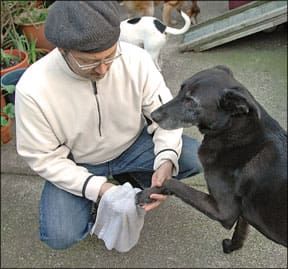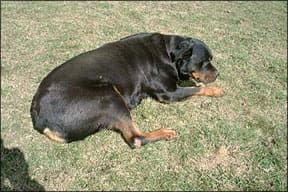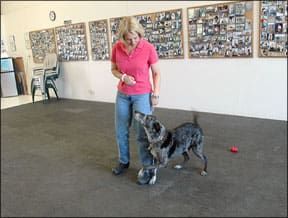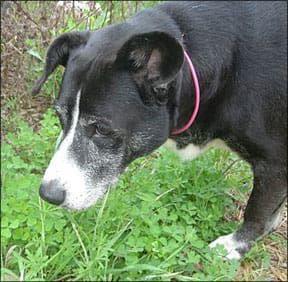Download the Full June 2007 Issue PDF
Changes in The Pet Food Industry
Last month, I mentioned that I was going to attend Petfood Forum, an industry conference held annually in Chicago. As it turned out, it was the perfect place to be while news was breaking daily about expanding recalls. All the players were there: manufacturers, ingredient suppliers, testing labs, and pet food company executives. It was an ideal place to be a fly on the wall – at least, until I gave the talk (“Scrutinizing Super-Premium Pet Foods”) that I was invited to present!

288
Given my general anxiety (I’ve never given a talk to a room full of people before), I may not be the best judge of the reception I received. It’s a fact that the room was full; my talk was well-attended. But it seemed to me that the audience, though polite, was also awfully quiet, almost grim. Well, the industry is taking its lumps right now, and I might have been just laying it on thicker at a time when they’d rather not be reminded about the importance of ingredient quality.
To their credit, I saw nothing but genuine contrition and concern from industry reps about the recent pet food recalls. I also never met or heard anyone at the meeting who appeared to be more concerned with covering their butts or “spinning” the news. Instead, I heard many, many discussions about how to change “business as usual” in the industry, how to improve pet food ingredient testing and tracing, product recalls, and consumer relations. Given the presentation I saw given by an industry analyst, indicating that the most robust growth in the pet food market is in the “natural, holistic, organic” sector, I get the feeling that the postures that I witnessed were authentic.
¡ö I’m sorry that certain articles that have been lurking on the “what’s ahead” box on page 24 have not yet been forthcoming, whereas other unanticipated articles keep cropping up! With their long production lead times, monthly magazines are not ideally positioned to cover breaking news stories like the pet food recalls, but we’ve been doing our best to cover these important issues in as timely as matter as possible – even if it has caused some chaos in our lineup. Long-overdue articles on essential fatty acids, puppy classes, and lipomas will appear as soon as possible.
¡ö Cooper, the Australian Shepherd who appears with me in the photo below, died on April 25 at the age of 13. He was my father-in-law’s dog, although in recent months he had been living with my husband and me in our part-time home in Oroville, as my in-laws were preparing to sell their house.
I’ve provided vacation dog care for Coop for a decade, and borrowed him frequently for product testing and modeling duty – he was a perfect model and could learn a new trick to perform for the camera within minutes. Besides chewing up a few dog beds, I can’t think of anything he ever did wrong. I’ll miss his cheery, goofy, sweet face – in person and in the magazine – more than I can say.
Home-Prepared Pet Food Diets
Those of us who feed our dogs a raw diet that includes bones believe that this is the healthiest, most natural diet dogs can eat. But not everyone is comfortable feeding such a diet to their dogs. You may worry about bacteria or parasites in raw meat, or about feeding your dog bones, or you may have a dog who doesn’t enjoy or do well on a raw dog food diet.
If you prefer to feed your dog a cooked diet, or a diet that includes raw meat but no bones, that’s fine. Your dog will still benefit from a variety of fresh foods in proper proportions, regardless of how they’re prepared. For simplicity’s sake, these diets are often referred to as cooked diets, but the meat portion may be fed raw if you choose.
Cooked diets that do not include bone are a little more difficult in terms of making sure that all of your dog’s nutritional needs are met. We can supply the calcium that bones provide from other sources, but it is hard to know exactly which other nutrients present in fresh bone might be missing in a bone-free homemade diet.
In addition, cooking destroys or reduces certain nutrients, such as vitamins C and E and taurine. Cooking in water also leaches out minerals, though this can be resolved by feeding the water the food was cooked in. Light cooking at lower temperatures has less effect on nutrient value than cooking foods until they are well done.

While dogs (particularly adult dogs) can survive on a wide variety of diets, this article will give you guidelines for optimal nutrition, to help your dogs live the longest, healthiest lives possible.
Review: three basic rules
As discussed in the first two installments of this series (“Home-Prepared Dog Food,” April 2007 and “Create a Nutritious Raw Dog Food Diet,” May 2007), the three most important rules of home-prepared diets apply to cooked diets, too:
–Variety: A homemade diet must include a variety of different foods, not just meat and grains. It’s best to feed many different types of meat (beef, lamb, pork, chicken, turkey, fish, etc.), as well as other foods such as organs, eggs, yogurt, and healthy leftovers.
Most people who feed cooked diets also feed grains or starchy veggies. If you do, make sure that meat and other animal products make up at least half the diet, and preferably more. Remember that dogs do not require carbohydrates, and they do not supply as much nutrition to dogs as animal products do.
–Balance over time: When you feed a wide variety of different foods, there is no need to make each meal “complete and balanced.” Think of how you eat yourself, and how you feed your children, providing different foods at different meals and on different days. Make sure your dog gets everything he needs over a week or two, not at every meal.
–Calcium: One of the most common mistakes that people make when feeding a home-cooked diet is the failure to add calcium. You must add calcium when you feed a diet that does not include bones.
Adult dogs need around 800 to 1,000 mg of calcium per pound of food fed. They also require the calcium to be supplied in a proper proportion to phosphorus.
The ideal calcium:phosphorus ratio in the canine diet is between 1:1 and 2:1. Meat contains a lot of phosphorus, so the more meat a diet contains, the more calcium will be required to reach the correct calcium:phosphorus ratio. Adding 800 to 1,000 mg of calcium will provide the correct calcium:phosphorus ratio even for a high-meat diet, unless you use a calcium supplement that also contains phosphorus. In that case, moderately higher amounts of calcium may be needed to balance out the additional phosphorus contained in the supplement.
Ground eggshell can be used as a calcium supplement. Rinse eggshells and dry them on a counter overnight, or in the oven, then grind them in a clean coffee grinder. One large eggshell provides one teaspoon of ground eggshell, which contains 2,000 mg of calcium, so add ½ teaspoon ground eggshell per pound of food fed. Don’t use eggshells that haven’t been ground to powder, as they may not be absorbed as well.
You can use other types of calcium supplements (any form of calcium is fine). Calcium from seaweed, such as Animal Essentials’ Natural Calcium, also supplies other minerals (including magnesium, iodine, and selenium) that are beneficial.
Bone meal is frequently used as a source of calcium in diets that don’t include raw bone. However, bone meal contains calcium and phosphorus. Different brands of bone meal supplements contain different amounts of calcium and phosphorus, but the calcium:phosphorus ratio is always the same: 2:1. To balance a canine diet that contains lots of phosphorus, then, such as one that contains mostly meat, you will need to give an amount of bone meal that will provide 1,000 to 1,200 mg calcium per pound of food to keep the ideal calcium:phosphorus ratio in the diet correct.
Look for bone meal supplements that are guaranteed to be free of lead and other contaminants. You can also use a purified bone extract called Microcrystalline Hydroxyapatite (MCHA), but most of these supplements also contain vitamin D in high amounts, which would not be appropriate to use (see supplements section further on in the text).
Another option is to use a supplement designed specifically to balance a limited diet, including supplying the proper amount of calcium. Wysong’s Call of the Wild supplement is meant to balance an all-meat diet that does not include bone. Call of the Wild derives some of its value from whole foods. Balance IT is another supplement created to balance a limited, incomplete homemade diet.
One last option is to use a dog food pre-mix to which you add meat, eggs, dairy, and other healthy foods. These pre-mixes will include calcium and other nutrients to balance out the fresh foods that you add. (“Home-Prepared Dog Food,” April 2007, has more information on pre-mixes.)
If you feed meat with ground bone, there is no need to add calcium. (See “Create a Nutritious Raw Dog Food Diet,” May 2007, for more information about diets containing ground bone.)
When you use supplements or pre-mixes designed to balance a limited diet, you should restrict the amount of liver you feed to no more than half the amount recommended below, due to high levels of vitamin A. Also, do not add cod liver oil (or other source of vitamin D) or kelp (due to the risk of excess iodine, which can interfere with thyroid function), unless the pre-mix instructs you to do so.
Remember that you should never feed cooked whole bones, unless they have been cooked into mush in a pressure cooker or by boiling for many hours. (This will only work with some chicken bones; other bones remain too hard no matter how long you cook them, though you can add some vinegar to the water to help leach out some of the calcium into the food.)
You can cook meat-based foods that contain ground bone, but this is not ideal. Cooking food that contains a large amount of ground bone can lead to constipation or even impaction. That’s why cooking ground-up necks, backs, wings, etc. – or commercial blends that contain ground bone – is inadvisable. Either feed this ground food raw, or add in an equal amount of meat (without bone) to lower the percentage of bone in the mix.
Again, when bones are fed, you don’t need to add calcium to the diet.
Types of foods, proportions
When feeding a homemade diet, it is essential that different types of foods be fed in appropriate proportions. Meat, eggs, dairy, and other animal products should make up at least half of the diet, and preferably more. The diet needs to include organ meats as well as muscle meat.
Liver and kidney should make up 5 to 10 percent of the total diet. It’s best to feed small amounts daily or every other day, rather than large amounts at one time. Because these organs are so nutrient-dense, use the raw weight to determine the amount to feed. For example, if you feed a total of 20 ounces of food daily, use 1 to 2 ounces of raw liver/kidney, even though the cooked weight will be less. If possible, make heart (nutritionally, more of a muscle meat) another 5 to 10 percent of the diet, or even more, though too much may lead to loose stools in some dogs.
Eggs are an excellent source of nutrition. They can be soft-boiled, hard-boiled, gently scrambled, etc., or fed raw, if your dog likes them that way. You can feed as many eggs as you want, as long as you still feed lots of variety.
Dairy products, such as yogurt, kefir, and cottage cheese, are well tolerated by most dogs and offer good nutritional value. Yogurt and kefir have the added advantage of providing beneficial bacteria (probiotics). These products should be added after the food is cooked. Goat’s milk may be tolerated by dogs who have problems with cow’s milk.
Muscle meat from a variety of sources such as beef, lamb, pork, chicken, and turkey should make up most of the rest of the diet. It can be fed ground or in chunks. You can also feed canned fish, such as jack mackerel, pink salmon, and sardines, once or twice a week. (There is no need to add calcium to those meals since the bones are included.)
Vegetables are optional, but provide many benefits. Leafy greens are among the healthiest veggies to feed; other good veggies include broccoli, cauliflower, brussels sprouts, bok choy, cabbage, turnips, rutabaga, celery, cucumber, bell peppers, zucchini and other summer squashes, carrots, and more. Spinach and swiss chard can be fed in limited amounts.
These veggies provide few calories, so I usually advise adding them on top of the amount of food you feed, rather than calculating them as a percentage of the diet.
Steaming is the best way to cook vegetables, as it removes fewer nutrients than boiling. You can add the water used to steam or boil veggies to the meal, as it will contain the minerals that were leached out during cooking (add leftover meat drippings, gravy, soups, sauces, etc., to make a savory broth). Some vegetables may cause gas if fed to your dog in large portions.
Grains, legumes (beans), and starchy vegetables (such as potatoes, sweet potatoes and winter squashes) are usually included in cooked diets, but remember that dogs do not require carbohydrates in their diet, and plants supply incomplete proteins for dogs. If you do feed them, it’s best if they’re a small percentage of the diet, around one quarter or less. At a maximum, carbohydrates should never make up more than half the diet, with the other half coming from animal sources.
Grains that can be fed to dogs include white rice, brown rice, oatmeal, barley, amaranth, quinoa, and bulgur. Just as with other foods, feeding a variety of different grains and carbs is better than always feeding the same kind. Remember that grains contribute to weight gain and sometimes other health problems. If your dog is overweight or suffers from allergies, arthritis, seizures, urinary incontinence, IBD, or other digestive disorders, you may want to try feeding a diet without grains or starchy carbs to see if your dog improves.
Fruits can be added to the diet in small amounts. Overripe fruits are easier to digest. Don’t feed grapes or raisins, which cause kidney damage to some dogs if too many are eaten. Good fruits to feed include apples, bananas, papayas, mangoes, berries, and melon. Remember that you can also include healthy leftovers (foods you would eat yourself) from your own meals in the diet you feed your dog.
Putting it together
While meals can be prepared individually, you may find it easier to cook up large batches at one time, and then divide the food into meal-sized portions and freeze. Because variety is important over time and not necessary at every meal, you can feed the same foods for a week or two, and then switch to something else when you make the next batch.
It’s best to add most supplements at the time of feeding, rather than mixing them in ahead of time, since many vitamins and other nutrients are affected by freezing or by exposure to light or air. The probiotics found in yogurt and kefir will also not survive the freezing process.
You can add herbs and spices if your dog likes them, but not onions, which can cause anemia in dogs. The small amounts in leftovers shouldn’t be a problem.
Amounts to feed
One of the first questions that comes up when anyone wants to switch to a homemade diet is, how much should I feed? There are guidelines that can help you figure out a starting amount, but remember that each dog is an individual. The amount of food needed by each dog will vary considerably depending on his activity level and metabolism, and such factors as the amount of fat in the diet. Keep a close eye on your dog’s weight whenever you switch diets and adjust the amounts you feed up or down as needed, increasing or decreasing no more than 10 percent at a time.
It’s healthier for dogs of all ages to be lean rather than plump. If you have a dog who is relatively inactive, or tends to gain weight easily, you can reduce the amount of fat in the diet by removing skin and visible fat from poultry, and by feeding leaner meats and low-fat dairy products. For dogs that need a very low-fat diet due to chronic pancreatitis or fat intolerance, boiling meat will remove most of the fat.
As a general rule, dogs will eat around 2 to 3 percent of their body weight in fresh food daily (use cooked weights for foods that are cooked). Large dogs will tend to eat a lower percentage and small dogs a higher percentage of their body weights. Toy breeds may need as much as 4 to 5 percent of their body weight daily, while giant breeds might eat as little as 1 ½ percent, or even less.
I start with around 2 pounds of food a day for a 100-pound dog (2 percent of their body weight), 1 to 1 ½ pounds of food for a 50-pound dog (2 to 3 percent of body weight), ½ to ¾ of a pound (8 to 12 ounces) of food for a 25-pound dog (2 to 3 percent of body weight), and 5 to 6 ½ ounces of food for a 10-pound dog (3 to 4 percent of body weight). When making your calculations, remember that ounces are not the same as tenths – 1.5 pounds is not 21 ounces (1 pound 5 ounces), it is 24 ounces (1.5 x 16).
If you feed two meals a day, divide the total amount in half for each meal. If you know your dog is very active, tends to be on the thin side, or eats more now than would be expected for his age and size, then start with higher amounts and feed fattier foods. If you have a couch potato, or a dog who is overweight or gains weight easily, start with less and feed lower-fat foods. Again, watch your dog’s weight closely, using a scale if possible, and adjust as needed.

Note that leafy green veggies supply few calories, so don’t count them in when calculating the amount of food to feed, but add them on top of the rest of the diet. If you have a dog who is overweight and likes veggies, this is one way to increase the amount of food that she can have without causing weight gain.
The fat content of the diet will affect the amount you feed. Most dogs should have a moderate amount of fat in their diet, which means limiting meats that are really high in fat, such as 75 percent lean ground beef and some ground lamb and pork products. When feeding poultry (e.g., chicken, turkey, duck), remove visible globs of fat, and maybe some of the skin as well, particularly if your dog isn’t very active.
If you find you need to feed less than the amounts recommended above to keep your dog at a healthy weight, try reducing the amount of fat, so that he can have more food in order to get the nutrients that he needs (but don’t feed a really low-fat diet, as that will cause your dog to feel hungry all the time).
On the other hand, if you find yourself having to feed more than would be expected for your dog’s size, you can increase the amount of fat. Working dogs and those who are very active and have trouble keeping weight on will benefit from a higher-fat diet. Keep in mind that dogs do not have problems with high cholesterol, so that is not a concern if you need to feed a high-fat diet.
Grains and starchy carbs can also affect weight. Dogs who have trouble maintaining their weight on a normal amount of food may benefit from added carbohydrates, while reducing them can help those who need to lose weight.
Making the switch
Most dogs have little problem switching to a home-cooked diet. If your dog is prone to digestive problems, you may want to make the change gradually. Add just one new ingredient at a time and wait a few days to see how your dog does before adding something else new, gradually increasing the amount of new food and decreasing the amount of the old.
If you add a lot of new ingredients at one time and your dog develops problems, it’s harder to tell what the cause might be. If your dog vomits or has diarrhea, return to his prior diet and make the change more carefully once his digestive system is back to normal. That may include feeding the new food separately from the old (at least a few hours in between meals), and feeding only one new food at a time, to see if your dog reacts to any of the new ingredients.
Supplements
The choice of whether or not to add supplements is an individual one. Healthy dogs fed a wide variety of fresh foods in appropriate proportions should have no need of supplements, though they may still benefit from them. The less variety you feed, the more necessary supplements become. Cooked diets are more likely to need supplementation, since cooking destroys or reduces some nutrients. Dogs with health problems may also benefit from certain supplements regardless of their diet.
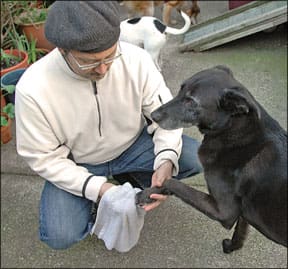
The most important supplement is fish body oil (not liver oil), such as salmon oil or EPA oil. This supplies omega-3 fatty acids, which provide a variety of benefits and are hard to find in any diet, whether homemade or commercial. The recommended dosage for healthy dogs is around 1 gram (1,000 mg) of fish oil per 20 to 30 pounds of body weight (dogs with certain health problems may benefit from higher doses).
When fed in doses high enough to supply the recommended amount of EPA and DHA, fish liver oil would contribute too much vitamin D. Restrict the amount of fish liver oil you feed your dog so that it does not contribute more than 100 IUs of vitamin D daily for a small dog (400 IUs daily for a large dog). Do not add cod liver oil or other sources of vitamin D to any commercial diet, as most are already high in vitamin D.
Note that flaxseed oil and carmelina oil are not good choices to replace fish oil, as the form of omega-3 fatty acids found in plant oils (alpha linolenic acid, or ALA) must be converted in the body to the forms that dogs can utilize (EPA and DHA). At best, dogs probably convert 15 percent of ALA to EPA and DHA; at worst, none of it. Fish, grass-fed meats, and eggs are also good sources of omega-3 fatty acids.
Whenever you add oils of any kind, you need to supplement with vitamin E, or the body will become depleted of this vitamin over time. Give around 100 IUs to a small dog (under 25 lbs), 200 IUs to a medium-sized dog (25 to 60 lbs), and 400 IUs to a large dog (more than 60 lbs), anywhere from daily to once a week.
Minerals are tricky to supplement, as they can be dangerous at excessive levels, or if they are not balanced properly with other minerals. For example, zinc binds with copper, so if you give a supplement that includes zinc but not copper in proper proportions (10:1), eventually this can lead to a copper deficiency.
Minerals are most safely supplemented in whole food form. Green blends that contain foods such as kelp, spirulina, Irish moss, fenugreek seed, and alfalfa are an excellent source of trace minerals. (Note that it is important not to give too much kelp, as it is high in iodine and too much can suppress the thyroid.) It’s best to give kelp in very small amounts – ¼ teaspoon or less for a large dog.
Organic apple cider vinegar, nutritional or brewer’s yeast, and dark molasses also supply trace minerals. Other fresh food supplements that may provide benefits include raw honey, ginger (especially good for digestion), and fresh crushed garlic (no more than 1 small clove per 20 pounds of body weight daily; more can cause anemia).
You may want to add probiotics, especially if your dog is stressed or ill, has been treated with antibiotics, or has had diarrhea. Supplements with multiple strains of beneficial bacteria are preferable to plain acidophilus. Digestive enzymes are also helpful for some dogs with gastrointestinal problems.
Puppies
The nutritional requirements of puppies vary from those of adults, and deficiencies (or excesses) are more likely to cause harm. Puppies need more protein, fat, calcium, and phosphorus than adult dogs do, but too much calcium can lead to serious orthopedic problems. This is especially true for young (prior to puberty), large-breed puppies. These increased needs continue as long as your puppy is growing, and are highest during periods of peak growth.
The exact amount of calcium that puppies require is a matter of endless debate among nutritionists. I’ll outline the most prominent recommendations, and suggest an approach that should result in your home-prepared diet falling into the middle of these ranges.
The 2006 National Research Council (NRC) guidelines recommend that puppies receive 3 grams (3,000 mg) of calcium per 1,000 kcals, which is four times its recommended amount for adult dogs. The minimum requirement was changed to 2,000 mg/1,000 kcals from its 1985 minimum of 1,600 mg/1,000 kcals.
The nutrient guidelines published by the Association of American Feed Control Officials (AAFCO) express the recommended amount in a different way, suggesting that puppy diets include between 1.0 and 2.5 percent calcium on a dry matter (DM) basis.
Some nutritional research suggests that large-breed puppies have optimal skeletal development and mineralization when fed a diet that contains between 0.8 and 1.0 percent calcium (DM), as long as the diet uses high biological value protein (from animal products) that provides 420 kcals per 100 grams of food. The percentage of calcium needed increases when caloric density is increased (higher-fat diets), so that the total amount of calcium per calorie remains the same. The percentage of calcium needed also increases when more grains are fed, since the phytates in grains bind calcium.
Studies have shown that skeletal abnormalities and lameness can result in large-breed puppies fed more than 2.6 percent calcium (DM), or more than 6,500 mg calcium per 1,000 kcals. Minimum amounts are less well-defined, but problems may occur when diets contain less than 0.6 percent calcium (DM). The amount of vitamin D in the diet will also have an effect, since it increases the absorption of calcium. Small-breed puppies can tolerate a much wider range of calcium than large-breed puppies without developing problems.
Here’s my suggestion: If you add an amount of bone meal that provides between 1,000 and 2,000 mg of calcium per pound of food fed (not counting any low-calorie veggies), this should provide adequate but not excessive calcium. If you cook the meat, use the cooked weight to determine how much calcium to add.
The higher amount of calcium in that range (2,000 mg per pound of food) will meet both NRC and AAFCO guidelines, providing between 2,000 and 4,000 mg of calcium/1,000 kcals and 1.6 to 2.0 percent calcium DM based on the diet recommendations I’ve given.
The lower amount (1,000 mg per pound of food) will provide between 0.8 and 1.0 percent calcium, which some feel is most appropriate for large breed puppies. This is lower than NRC and AAFCO minimums, but not low enough to cause deficiencies. Remember, you need to add more calcium per pound of food fed if you use a high-fat or high-grain diet.
Because puppies also need more phosphorus than adult dogs, I suggest using bone meal for a calcium source, rather than a calcium-only supplement. (Again, bone meal contains calcium and phosphorus in a ratio of 2:1.)
If your dog’s diet provides calcium in amounts that fall at the low end of the ranges suggested by experts, it’s advisable to supplement the diet with vitamin D, which enhances calcium uptake. (Don’t use calcium supplements that contain vitamin D, though, as the amounts will be too high). If you want to do your own calculations, you can analyze the diet you’re feeding using a nutrition analyzer (see “Resources for a Homemade Diet,” next page).
Remember that if you feed a diet that includes ground bone in appropriate amounts, there is no need to add additional calcium or phosphorus, as bone supplies both minerals in the right proportions. (Isn’t nature wonderful?)
Puppies also require more protein than adult dogs. Remember that there is no danger in feeding high-protein diets to puppies. The best thing you can do for large- and giant-breed puppies is to keep them lean and slow-growing by limiting the total amount fed, not by limiting the percentage of protein in the diet.
Most puppies will do well on a diet that has a moderately high amount of fat. Puppies need more fat than adult dogs, but too much can lead to rapid growth (if they get too many calories), or limit nutrition (if you have to feed less than the normal amount to control growth). If you have a very active puppy who eats more than would be expected for his age and size, then you can increase the amount of fat in his diet. Don’t feed a low-fat diet to a puppy.
Figuring out how much to feed a puppy will depend on the pup’s age as well as current weight and anticipated adult weight. Puppies eat much more for their weight than adult dogs do, and young puppies eat more for their weight than older puppies do. That’s one of the reasons why it’s important to feed younger puppies three to four meals a day.
The amount fed to puppies should gradually increase from a little over half of the appropriate adult serving (when the puppy is very young) to close to the adult ration (for older puppies). Here’s what that would translate into based on percentage of current weight:
1/4 grown:
4.5 to 6.5 percent of current body weight (55 percent of adult diet)
1/2 grown:
3.5 to 5.25 percent of current body weight (88 percent of adult diet)
3/4 grown:
2.75 to 4 percent of current body weight (100+ percent of adult diet)
Fully grown:
2 to 3 percent of their body weight daily (100 percent of adult diet)
Small-breed puppies reach their adult weights more quickly than large breeds do. A small-breed puppy will eat as much as an adult by the time she’s around three months old. A large-breed puppy will eat as much as an adult by the time she’s around 5 months old. In both cases, they’ll eat a little over half that amount at 8 weeks of age. Small breeds will eat a higher percentage of their body weight daily than will larger breeds.
Keep in mind that the appetite of puppies is notoriously varied – they eat more when they’re in a growth spurt and less when they’re dealing with hormones and teething – so it’s important to pay attention to the individual dog and adjust as needed. It’s best for puppies to be lean, not chubby, especially the large breeds; keeping them lean will decrease the likelihood of hip dysplasia and other orthopedic problems developing. Adjust the amount of food as needed to keep your puppy at the proper weight, with ribs easily felt and not covered in fat.
The rewards
Feeding a cooked diet takes time and may cost more than feeding packaged foods (though it’s possible to keep costs down by shopping sales and ethnic markets, and buying food in bulk), but the rewards are many. Dogs fed properly prepared homemade meals are usually healthier than dogs on commercial kibbled or canned diets, and you may find your vet bills are reduced. There is much joy in watching our dogs eat fresh, healthy meals we have prepared ourselves, knowing the quality of the ingredients and the value they provide, as well as the obvious enjoyment our dogs get from their food.
Carol Morgan of Mauldin, South Carolina, expressed the feeling very well. “I home cook for my two dogs, both Australian Shepherds,” says Morgan. “Six-year-old Rowdy gets 100 percent home-cooked, and eight-year-old Tillie gets kibble supplemented with home-cooked. Both dogs also get some raw fruits. Getting started was a very big undertaking; I spent a lot of time on the Internet and reading books while designing their diets. When my vet next saw my dogs, she called everyone into the office to see them because of the obvious improvement in their health. I will never go back to 100 percent commercial dog food again.”
Mary Straus does research on canine health and nutrition topics as an avocation. She is the owner of the DogAware.com website. She lives in the San Francisco Bay Area with her dog Piglet, a 15-year-old Chinese Shar-Pei.
Whole Dog Journal’s Guide to Canine Health Books
Having a solid library of canine literature, or at least a shelf or two full of good books, is a great hedge against making uninformed decisions about your dog’s health. Of course, a trip to your veterinarian is your first line of defense when something is obviously wrong with your dog. But we suggest hitting the books for information before and after vet visits.

200
A good canine health handbook can help you interpret what your vet tells you, give you ideas for further questions to ask, bolster your argument for a different type of treatment, and give you a list of invaluable home healthcare practices you can put into place to speed your dog’s recovery – or better yet, prevent problems in the first place.

200
One challenge is finding health-oriented texts that are not dogmatic in their insistence on conventional medical approaches to the exclusion (if not derision) of all else. I’ve seen complementary and alternative approaches succeed where conventional medicine has failed too many times to throw the puppy out with the bathwater. The canine health books highlighted here take a truly holistic, inclusive approach to animal healthcare.
I have several $300 veterinary textbooks on my office shelves for reference and fact-checking articles, but it’s amazing how frequently I find the answers I am looking for in the following books!
Caring For Your Dog, by Bruce fogle, dVM. 2002, dk Publishing, inc. 448 pgs.

200
Only conventional medical approaches are discussed in this book, but it’s the most complete, well-researched, and well-illustrated general dog health book I’ve seen. Hundreds of color photos and medical illustrations help owners visualize the conditions and anatomy discussed. Amazingly, Dr. Fogle is refreshingly not hostile to home-prepared diets.
And no kidney stone goes unturned! The book contains at least a bit of helpful information about every medical condition I’ve ever needed to look up.
The Complete Holistic Dog Book, by Jan allegretti and katy Sommers, dVM. 2003, celestial arts. 372 pgs.
This book succinctly and convincingly describes the benefits (and basics) of a healthy lifestyle and holistic healthcare for dogs. Healthy diets and complementary modalities (acupuncture,

161
chiropractic, homeopathy, and herbal medicine) are described and indications for their best use are suggested. The section on the “holistic medical chest” will be useful to owners who are new to providing safe, effective home treatments for their dogs.
The Pet Lover’s Guide to Natural Healing for Cats & Dogs, by Barbara fougère, BVSc. 2006, elsevier inc. 628 pgs.
The design of this book is a little odd, but once you get past this superficial aspect, you’ll discover a wealth of suggestions on conventional and complementary treatments for numerous health conditions. Home-prepared diets and supplements are discussed in depth, and overall, Dr. Fougère’s treatment philosophies closely complement ours! As the title suggests, feline care is covered, too.
The Encyclopedia of Natural Pet Care, by cJ Puotinen. 2000, McGraw-hill. 544 pgs.
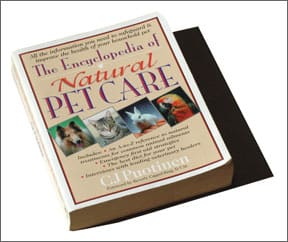
161
My copy of this book (pictured above) is a first edition; a newer edition was published in 2000. Written by longtime Whole Dog Journal contributor CJ Puotinen, this book is calm, warm, and encouraging. It gently helps inspire owners to take increasing responsibility for their animal companions’ health, through improved diet and less-toxic care practices. Puotinen describes opportunities for owners to use flower essences, herbs, supplements, and hands-on therapies to make a palpable improvement in their dogs’ health. The book also includes interviews with a number of high-profile holistic veterinarians.
Holistic Guide for a Healthy Dog, by Wendy Volhard and kerry Brown, dVM. 2000, howell Book house. 314 pgs.

161
Wendy Volhard was one of the pioneers of home-prepared diets for dogs, and is still considered a guru for those feeding a certain type of diet. She and Dr. Brown are strong proponents of grains in canine diets, which may not jibe with other authorities’ opinions, but the authors do have decades of experience and terrific results behind them.
Sections on less-mainstream modalities such as kinesiology and homeopathy are well-described. The section on thyroid and adrenal abnormalities and treatments for these conditions is worth the price alone.
Hound Health Handbook, by Betsy Brevitz, dVM. 2004, Workman Publishing. 468 pgs.

161
Only conventional medical care is recommended in this book, so you have to take suggestions on diet and vaccinations with a grain of sea salt. But Dr. Brevitz’s descriptions of the causes and symptoms of so many medical problems earns this book a place on our shelf. Also, we applaud her inclusion of a chapter on mental health and behavior problems; many veterinarians fail to consider these as “health” issues, even though the problems are responsible for the loss of millions of dogs’ lives (through euthanasia). A list of common physical health problems endemic in an alphabetical list of breeds is another highly valuable tool.
Help Your Dog Fight Cancer, by laurie kaplan. 2004, Jan-Gen Press. 120 pgs.
Obviously, this book is not a general health guide. But the author does such a thorough job in describing the total care program needed to help her dog through a long fight with cancer, that literally every type of healthcare is discussed.
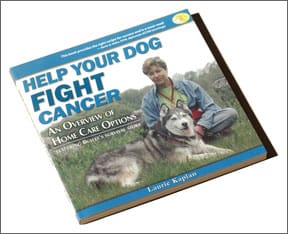
161
Kaplan discusses diagnostic tools, various cancer treatments conventional and alternative), how to interpret lab tests, and how to communicate with veterinarians and make informed medical (decisions. She also does an especially good job of describing (and illustrating with photos!) how she formulated and prepared a homemade “anticancer” diet for her dog (who, by the way, outlived his diagnosis by years).
Dogs and Cats Living Together
MULTI-SPECIES HOUSEHOLD OVERVIEW
What you can do…
– Do some research before adding a new species to your family, so you can make adoption choices that have the greatest likelihood of success.
– Recruit friends and family to assist you in orchestrating careful introductions.
– If your animal companions already have undesirable associations with each other, commit to a training and behavior modification program to create peaceful relationships.
– Use fail-safe management protocols to protect everyone.
You’ve no doubt heard the phrase “fighting like cats and dogs.” As well-known as the saying is, it’s also an often inaccurate one. Millions of dog lovers share their hearts and homes with feline family members with nary a scratch between the species.
On the other paw, stories of dogs killing cats are fact, not fiction, and many unfortunate Rowdy Rovers have suffered ulcerated corneas, scratched nose leathers, and infected puncture wounds from Tough Tiggers who decided that “fight” was a better strategy than “flight.” What determines the difference between Fido and Fluffy amicably sharing the sofa and one or both ending up at the emergency clinic – or worse?
The media likes to play up stories about personality differences between “cat lovers” and “dog lovers,” but many of us are both. We may also fill our lives with one or more small animal companions including rabbits, rats, ferrets, guinea pigs, iguanas, fish, finches, macaws, and a multitude of other creatures. It’s our responsibility and obligation as their guardians to ensure that they have a safe, reasonably low-stress environment in which to live – sometimes a large challenge when we’re asking predator and prey species to live in harmony. Whether the multi-species household is one big happy family or not depends on reasonable pet adoption decisions, careful introductions, good management, dog training and behavior modification, and a little – or a lot – of luck.
Sensible Adoption Selections and Careful Introductions
When we found our Scottish Terrier running loose in Chattanooga as a stray at age seven months, we were impressed with how well he adapted to our household. Despite warnings from other Scotty owners about the breed’s propensity for attacking cats, Dubhy couldn’t have been better behaved with our two geriatric felines. However, a year later we brought home an eight-week-old stray kitten, and Dubhy came close to committing kitty mayhem when we foolishly assumed he’d be fine with her. Perhaps we were unwise to keep Dubhy if we wanted to be able to adopt future cats safely, or perhaps it was the choice to bring home a new kitten that was foolish.

Lulled into a false sense of complacency because Dubh was so good with our adult cats, I ignored the sound advice I give so often to others about carefully orchestrated introductions, and walked into the house with the foundling kitten in my arms. (The right way to accomplish this is detailed in “Carefully Orchestrated Introductions,” below.) Five dogs charged up to me in greeting, and the kitten did a classic Halloween cat imitation, complete with arched back, bottlebrush tail, and alarmingly loud hissing and spitting. While our other four dogs backed off in awe and respect, this highly arousing stimulus immediately turned on Dubhy’s “fierce predator” switch.
Had we introduced Viva to the dogs one at a time, at a distance, with the canines carefully restrained, she probably would have reacted much more calmly, and Dubhy might never have “turned on” to her. Feeding treats to dogs and cat at the same time might have helped create an “other species makes yummy treats happen!” association. Once the predatory association was made, however, it was too late to un-ring the bell. We would have to work to repair the damage.
To maximize your chances for harmony between species, it’s smart to select individuals who have a high likelihood for compatibility. Since terriers were originally bred to rid barns, homes, and fields of unwanted rodent pests, it may be unwise to adopt a rat – or even a cat – as a pet, unless you are prepared to do a significant amount of very careful management – or you know your Parsons Russell Terrier well enough to be confident that he’s not a typical representative of his breed and won’t present a serious risk to Ricky Rat.
It’s also smart to select younger, rather than older. If you want a dog who will be trustworthy around other small animal species, you’re generally better off starting with a pup and raising him to know only appropriate behavior around other animals. It’s much more challenging to change inappropriate behaviors and associations in an adult dog than it is to create appropriate ones initially in a young dog. Alternatively, to keep life simple you can choose to adopt a dog who has a known history of living peacefully with other types of animals.
Of course there are exceptions to the species-compatibility rule. Decades ago my very gentle torti-tabby cat, Tofu, lived in perfect harmony in my bedroom with my breeding pair of canaries and their clutch of nestlings. She never even cast yearning glances at them. Long before I knew anything about behavior modification, I was proud of my success in getting predator and prey to live together peacefully.
Truth be told, this was more a case of luck – Tofu was a very nonpredatory cat – than any skill on my part. I looked forward to a long and happy canary-raising hobby – until the day my roommate’s cat accidentally got shut in the room. When I returned from work at the end of the day I was devastated to find only beaks and claws scattered about the carpet. I had failed my vulnerable charges.
When you’re contemplating adding a new family member, be wise. If your dog has a history of killing cats in your backyard, a feline may not be the best choice for you, especially if you intend to let your cat outside (not something I recommend, but that’s a different discussion). On the other hand, some dogs who chase – and kill – cats outdoors can live safely with their own cats indoors, where the cats are less likely to run and thus trigger the predatory response. Still, it’s a greater compatibility risk than a dog who shows no desire to chase/attack cats.

Good Pet Management
I thought I was doing a darned good job of managing the risks to my tiny avian family’s safety. I was wrong – and they paid for it with their lives. Fortunately we did a far better job of managing Dubhy’s behavior with the eight-week-old kitten who triggered his hardwired Terrier prey behavior. We expect Viva, now age three, to live a long and happy life with us. She and Dubhy are fast friends these days, no management necessary.
Good management requires effective barriers (doors, baby gates), sturdy containment units (crates, pens), restraint (leashes, tethers), and unwavering supervision (your eyeballs and awareness). However, all of your management tools are only as good as your ability to ensure their use. A moment’s lapse can result in beaks and feathers instead of warm breathing beings, and sooner or later there’s likely to be a lapse.
If your children (or roommates) aren’t good at heeding your warnings to keep doors closed, or if your talented canine can open doors, you might need to add self-closing springs, child-proof latches and/or padlocks to your list of management tools. You’re likely to be more successful in the long run commingling species if you combine a foolproof management plan with an effective program of training and behavior modification.
Good Pet Training
After taking emergency management precautions with our new kitten, I set to work creating the associations I should have arranged from the start. I did a boatload of counter-conditioning, feeding high-value treats nonstop when Viva was in Dubhy’s presence, quietly restraining him if he lunged at the tiny cat (I’ll describe how to conduct counter-conditioning and desensitization sessions in a moment). By the end of the first session Dubhy was lying at my feet, not taking his eyes off the kitten, and happily munching treats.
The next day my husband was hospitalized, and I had neither the energy nor the heart to work on the Dubhy/kitten relationship. I kept them separated while I divided my energies between hospital, home, and training center.
Five days later, I was ready to address the challenge again, and prepared for another difficult evening. With Viva safely on the back of the sofa, I brought Dubhy into the room. Bless his little Scottish heart, he was clearly excited to see the kitten again, but he looked at her, then laid down on the floor at my feet and looked up at me, clearly saying “Okay, where’s my treat?”
The rapid progress continued over the next few sessions. There were tears in my eyes at the conclusion of session five as I watched Dubhy and Viva lying together on the sofa, with the tiny black feline occasionally taking a playful swipe at Dubhy’s nose with her paw, and Dubhy declining to take offense. Even when she raced across the room, a sure trigger for a predatory chase, Dubhy controlled himself – key: controlled himself – I didn’t have to say a word. He jerked forward as if to take off after her, then thought better of it, settled back onto his blanket and looked at me. And yes, he got a big delicious treat jackpot!
Counter-Conditioning and Desensitization
We talk about the process of counter-conditioning and desensitization (CC&D) a lot in Whole Dog Journal articles. That’s because it’s such an effective behavior modification tool that it can be applied successfully in an almost endless number of behavior challenges.
All living things – at least those with a central nervous system – learn and respond to their environment through two primary pathways: classical (or respondent) conditioning and operant conditioning.
With operant conditioning, the dog operates on the environment. That is, the dog does deliberate behaviors in an effort to make good stuff happen and bad stuff go away. For example, your dog chooses to offer a sit because he knows there’s a good chance it will result in you paying attention to him and perhaps feeding him a tasty treat.
With classical conditioning, the environment operates on the dog, triggering a response as a result of a prior association between two stimuli in the dog’s experience. Something happens in the dog’s world and the dog has an emotional and/or biological response.
For example, your dog hears the “click!” of the clicker and starts to salivate because his brain has made the association between the click! and the arrival of a yummy morsel. He doesn’t have to think, doesn’t have to decide to salivate – it just happens. He also wags his tail and gets happy – all automatic responses because of his association between click! and treat.
A dog’s desire to chase something that moves is an innate, hardwired behavior; it doesn’t have to be learned. It is certainly stronger in some dogs than others, due to genetic influence. We have intentionally bred some dogs to be more turned on by movement than others; herding dogs, terriers, and sighthounds leap to mind. Still, it’s the association between the presence of the cat and the dog’s experience that cats often run away that make the feline a high-arousal chase object.
We use counter-conditioning to change the association with a stimulus. If we can replace the “cat = rousing game of chase/kill” association with “cat = totally delicious treat from human” association we have “countered” the prior association with the new one. (In Australia I heard it called “reverse conditioning,” which makes a lot of sense.)
Classical and counter-conditioning are both happening all the time. When you click and treat your dog for sitting, operant conditioning happens. The dog learns that he can sit to get you to click the clicker, so he sits more often. He’s also associating the sound of the click with food, and associating training in general with good stuff – having fun with you and eating treats.
However, when your dog is in the throes of a strong emotional response – high arousal, fear, great excitement – operant conditioning goes out the window. This means that when your dog is barking and lunging at your cat, or chasing your ferret madly through the house, he is unable to respond to your cues to come or lie down. It’s not that he’s deliberately ignoring you; he truly can’t think clearly enough to register and act on your cue.
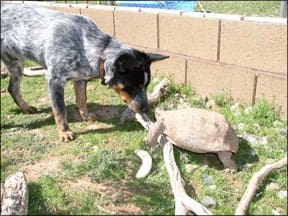
That’s why changing the dog’s emotional response is a much more effective way to modify his behavior than yelling at him, or asking him to perform an operant behavior. When his emotions are under control, then he can sit when you ask him to, but not before that. The sequence of events that is most likely to produce effective counter-conditioning is this:
1. Stimulus (cat) appears at sub-threshold distance, which is the distance at which the dog sees the cat and becomes alert but doesn’t start barking and lunging.
2. Owner begins feeding bits of high value treats to the dog as long as the cat is in view near threshold distance. (I like to use chicken for this as it is very high value for most dogs).
3. Cat disappears from view.
4. Owner stops feeding treats.
5. Repeat these four steps until when the cat appears, your dog looks at you with a big “Where’s my chicken?” grin on his face. We call this a “conditioned emotional response” or CER. When you have a consistent CER at your starting distance, you can decrease the distance slightly and repeat steps 1 through 4. Every time you obtain consistent CERs you can increase the intensity of the stimulus – bring the cat closer, have the cat move a little faster, introduce two cats . . .
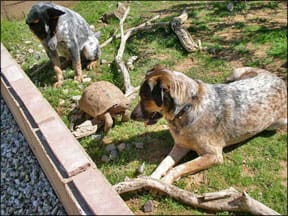
The process of changing the association from inappropriate to appropriate is the counter-conditioning part. Increasing intensity of stimulus is the desensitization part. Done well, you end up with a dog and cat (or chinchilla, parrot, snake, tarantula) living safely together, just like Dubhy and Viva.
Combined Approach
Despite our stunning success in a very short time – who says positive methods take longer? – we continued to manage Dubhy with Viva by keeping them in separate rooms when we weren’t home to directly supervise, until the baby cat was six months old and better able to fend for herself. Viva’s healthy presence in our lives today is testimony to the effectiveness of our management and modification efforts.
Dubhy hasn’t lost one whit of his terrier gameness, however, as demonstrated recently. We share our farm with a fair number of black snakes, which is more than fine with me. I actually love snakes, and they are a big help with our resident wild rodent population. A few weeks ago I heard a Scottie commotion in the backyard while I was cleaning stalls in the barn. By the time I arrived to see what the fuss was about he had, much to my dismay, killed a six-foot black snake that was crossing the yard. Guess I won’t be keeping any snakes as pets in the near future!
If you combine basic good manners training with your program of counter-conditioning and desensitization you’re even further ahead. The better you and your dog can communicate to each other, the more effectively you’ll be able to control his behavior when the need arises.
Lucy, our Cardigan Corgi, is also fond of chasing cats, albeit from the herding dog “Whee, it’s fun to chase and round up things that move!” perspective rather from the terrier “KILL!” motivation. Although her motive is gentler, she is still capable of making the cats’ lives miserable. Counter-conditioning worked for her as well, but while Dubhy has completely given up any “kill” association with Viva, Lucy still yearns to chase our cats when they move. Her well-practiced “leave-it,” “come,” and “down” cues give us an added layer of insulation against inappropriate cat tormenting.
Carefully Orchestrated Introductions
Your chances of a successful multi-species relationship are best if you plan their introductions carefully. It’s rarely wise, although it sometimes works, to simply march in with a new family member and, in essence, “throw her to the wolves.” Far better to have both or all) nonhuman family members safely restrained and have the introduction be a positive classical conditioning experience or counter-conditioning if one or more of the participants have some prior association with the other’s species).
Here’s an example of a well-orchestrated introduction. For other species, substitute “other” for “cat” and figure out how to alter the process as appropriate. For example, “snake in tank” rather than carrier, and at some point human would hold the snake, rather than releasing her to roam around freely. Depending on participants, the processes described could take several weeks, or could occur all in one session.
PARTICIPANTS: Dog and Cat, 2 Humans
– Have cat in carrier.
– Place carrier on floor on far side of room.
– Enter with one dog on leash.
– Do classical conditioning (feed treats!) with both dog and cat at subthreshold distance until both are offering conditioned emotional responses (CERs) in the presence of the other.
– Decrease distance between dog and cat and repeat process to obtain CERs.
– When both are comfortable when the dog is in close proximity to the cat in her crate, return to the original distance and remove the cat from crate (but keep her restrained, ideally on harness and leash).
– Repeat CC&D process until dog and cat are comfortable in close proximity, both restrained.
– Return to original distance and release cat (dog is still restrained).
You will find that some species are more difficult to incorporate in the process as anything more than a silent presence. Because of the feeding habits of snakes, for example, it would be difficult to do CC&D with a snake as the dog enters the room and approaches the snake’s tank. In this case you may just have to settle for desensitization (becoming accustomed to the increasing intensity of the stimulus — the dog) without the classical conditioning (association) part.
Rehoming
There may come a time when you decide that it’s in the best interests of all concerned to remove one or more species from your household. This is a painful decision for any animal lover – and a very selfless one. It’s not easy to put the welfare of your cat, hamster, or cockatiel above your own emotional connection and feelings of commitment and responsibility. You may feel guilty that you perhaps haven’t done as much to make the situation work as you could – or should – have.
But with someone’s life is at risk, rehoming really is the best choice. This will give the at-risk pet a better chance for a long and happy life and remove much stress from your own home, thereby improving the quality of life for all your remaining family members, including yourself.
There must be millions of successful multi-species households, so chances are good that if you put your mind to it, you can make it work for yours. Take time to make wise adoption choices, orchestrate careful introductions, implement good management and training programs. If you do all this, you will likely succeed in your desire to turn your home into a peaceable kingdom, where lions lie down with lambs – or at least cats and dogs can live peacefully with canaries, rabbits, and boa constrictors.
Pat Miller, CBCC-KA, CPDT-KA, is Whole Dog Journal’s Training Editor. Miller lives in Hagerstown, Maryland, site of her Peaceable Paws training center. She is also the author of The Power of Positive Dog Training and Positive Perspectives: Love Your Dog, Train Your Dog.
Canine Cancer Therapy Update
Despite everything modern medicine has to offer, cancer remains among the most feared of canine diseases.
Just over a year ago, Whole Dog Journal reviewed conventional, complementary, and alternative cancer therapies in a series of articles (“Canine Cancer Crisis,” November 2005; “Conventional Cancer Care,” December 2005; “Don’t Despair, Just Care,” January 2006, and “What Are the Alternatives?” February 2006) Since then, a cancer vaccine has been approved for veterinary use and a new version of an old herbal salve has become a “first choice” for many holistic veterinarians. Here’s what’s new.
Melanoma vaccine
Most vaccines are designed for prevention, but a new type is designed to treat active disease. The U.S. Department of Agriculture recently approved such a vaccine for the treatment of canine melanoma.

288
“Everything about this vaccine is unusual,” says Gerald Post, DVM, a Norwalk, Connecticut, veterinary oncologist and founder of the Animal Cancer Foundation. “In addition to being therapeutic rather than preventative, it contains human DNA. Injecting an animal with DNA from a different species can effectively stimulate an immune response that attacks cancer cells.”
The vaccine is a result of collaboration between human and veterinary oncologists at the Animal Medical Center in New York City, Memorial Sloan-Kettering Cancer Institute, and the drug’s manufacturer, Merial.
Melanomas are usually solitary black tumors, and those appearing on the mouth or nail bed are usually malignant. Dr. Post understood the prospects all too well when, four years ago, he noticed a tiny lesion on one the toes of his own Miniature Schnauzer, Smokey.
“It was metastatic melanoma,” says Dr. Post. “When I saw the x-rays and biopsy report, I was devastated. It had already spread to his lungs, and the average survival time for dogs with this type of cancer is about three months.”
Smokey, who was 12½ years old at the time, was such a healthy, vibrant dog that Dr. Post worked frantically to save him.
“At that time the melanoma vaccine was still very new and experimental,” he says, “but I didn’t hesitate to try it as everyone I consulted agreed that it looked like our best hope. I was really pleased when he lived an additional two and a half years. The vaccine didn’t cure him, and eventually the tumor came back, but it gave him extra time and an excellent quality of life. The result was far more than I had dared to hope for when I first made the diagnosis.”
Dr. Post was particularly pleased because Smokey never experienced an adverse side effect. “In the beginning Smokey received the vaccine every two weeks for two months,” he says. “After that, he got it once a month or so. Smokey responded really well, and throughout his therapy, you would never know that anything was wrong or that he was under any kind of treatment.”
In this respect, Smokey was like most patients. “I’m loathe to say that no dog will ever have an adverse side effect,” says Dr. Post, “but adverse reactions are very, very rare. None of the 50 or more dogs that I sent to the Animal Medical Center to receive the vaccine over a period of four to five years experienced any adverse side effects that I’m aware of.”
According to Dr. Post, the ideal candidate for the melanoma vaccine is a dog whose condition is discovered early, before it metastasizes, when it can be well controlled locally. “Obviously,” he says, “the earlier you find the disease, the better. You don’t want to wait until it has spread.”
In March 2007, the USDA issued a conditional U.S. Veterinary Biological Product License for the vaccine. During the conditional licensure period, Merial will conduct additional research supporting the vaccine’s safety and effectiveness. During this time, it will be distributed by veterinary oncologists.
“I’m excited about the release of this vaccine,” says Dr. Post, “because it’s exactly the kind of medical breakthrough that the Animal Cancer Foundation was created to fund. It’s an innovative, novel therapy, it treats a really serious problem, it’s effective, and it helps not only dogs but people, too. The same technology that created the canine melanoma vaccine is being researched for human melanoma.”
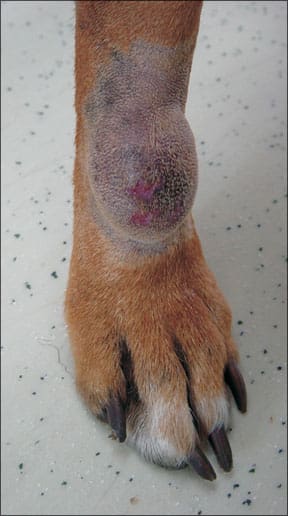
167
Neoplasene
Our February 2006 article (“What Are the Alternatives?”) on alternative cancer treatments described bloodroot salves, also called black salves, which have been used in the treatment of many types of cancer in humans, dogs, cats, horses, cattle, and other animals. Salves containing bloodroot (Sanguinaria canadensis) are red when first made but turn dark or black with age, hence their common name.
Herbal treatments are popular because they are inexpensive (or at least less expensive than conventional treatments) and they are usually gentle, easy to use, and unlikely to cause adverse side effects.
“Bloodroot salves are generally less expensive than chemotherapy or radiation,” says Deborah Cihonski, PhD, founder of a black salve Internet forum, “but that’s where their similarity to other herbal therapies ends. Bloodroot salves are rarely gentle, and I always recommend that a veterinarian supervise treatment.” Dr. Cihonski, a pediatric psychologist who lives in Tampa, Florida, and Chicago, first heard of black salves from her Chicago veterinarian, Kimberly Curtis, DVM, when her young cat, Piper, was being treated for vaccine-associated fibrosarcoma.
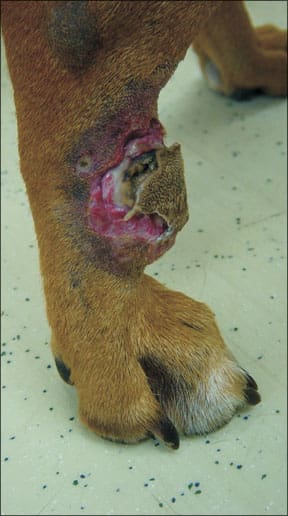
167
“I had taken him to the University of Illinois veterinary oncology department,” she says, “and they said there wasn’t much they could do for his long-term survival. They suggested a very expensive treatment that involved leaving him there for nearly two months of radiation, chemo, and bone-removal surgery. This, they hoped, would allow him to live another three years at most.” Dr. Cihonski had lost several dogs to cancer after aggressive and heroic treatments. “These rarely worked out to anyone’s favor,” she says, “so I was open to alternatives for Piper.”
Piper had received several months of herbal therapy when Dr. Curtis mentioned hearing about black salve, which she thought might be helpful for him. Dr. Curtis discovered Neoplasene and consulted with its manufacturer, Terry Fox, PhD, at Buck Mountain Botanicals in Miles City, Montana.
Traditional black salves are made with zinc chloride, a caustic chemical that burns the skin. In contrast, Dr. Fox uses zinc chloride to make a highly ionic solvent with which he extracts bloodroot’s isoquinoline alkaloids. Although it is used in Neoplasene’s production, zinc chloride is not contained in the final product. Neoplasene’s bloodroot alkaloids comprise a small but vital portion of its ingredients. According to Dr. Fox, the isoquinoline alkaloids are modified in such a way as to cause diseased tissue to self-destruct preferentially, sparing healthy, normal non-cancerous tissue.
Four forms
There are four Neoplasene products: Neoplasene salve (which is also known as Sarcoma #1) for topical application; Neoplasene oral; and two types of NeoplaseneX for intravenous use or injection directly into tumors.
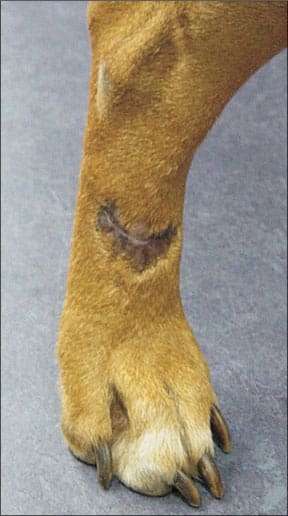
167
Dr. Curtis and Dr. Cihonski used Neoplasene salve to remove Piper’s tumor, then switched to oral Neoplasene to complete his treatment.
“We did the same thing with my pet chicken, who had major tumors that were very vascular,” says Dr. Cihonski. “We almost lost her in surgery so we had to explore other treatment options. The results were successful in both cases.”
Throughout her study of alternative cancer therapies, she kept wishing that Neoplasene had been available years ago, when her Rottweilers suffered from osteosarcoma, hemangiosarcoma, and malignant histiocytosis. “I kept thinking that this could have helped them when nothing else did.”
One year ago, Jackie, a three-year-old Jack Russell Terrier belonging to Dr. Cihonski’s mother, Phyllis Cihonski, developed a tumor on her foot. “It was diagnosed as a histiocytoma,” says Mrs. Cihonski. “These are most frequently benign and often disappear spontaneously. The only prescribed treatment was antibiotics for infection, and if necessary, the toe would be removed. I felt that treatment with the oral Neoplasene was preventative. Within days of beginning the treatment the tumor regressed and then disappeared. Jackie is a happy, active dog, and she still has all of her toes.”
Although the application of Neoplasene is easy, Dr. Cihonski warns that it is best used by an informed consumer with the assistance of an experienced veterinarian. “The results are simply beyond what most people expect,” she explains, “especially the topical salve. When a tumor falls off, it can leave a huge wound behind, and that can be very frightening. This was certainly true in the case of my own animals, whose wounds looked awful. However, the wounds never became infected even though I didn’t treat them with antibiotics or disinfectants. I just kept them clean and lubricated.”
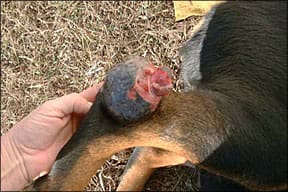
288
Lubricating salves or oils help speed healing and keep skin pliable.
It makes sense, says Dr. Cihonski, to start with oral Neoplasene because some tumors respond quickly, sparing patient and caregiver the inconvenience of extensive wound care. “You won’t know until you try what the results will be,” she says. “My chicken responded well to oral Neoplasene, but it did nothing for my cat. Some dogs get immediate results and others don’t. In some cases of very aggressive or advanced tumors, topical application is the best line of defense.
“In some cases,” she continues, “animal guardians have given their dogs oral, topical, or injected Neoplasene only to produce dramatic results that they did not consider positive. Some have stopped treatment altogether. The same is true for chemotherapy and radiation. When you’re dealing with cancer, you’re dealing with a serious, complicated illness. I wish there were a works-for-everything cancer treatment that is gentle, easy to use, 100 percent effective, entirely free from side effects, and painless, but if there is, I haven’t found it.”
For those interested in using Neoplasene, says Dr. Cihonski, the choice of treatment depends on the patient, the type of cancer, its location, and its stage of growth.
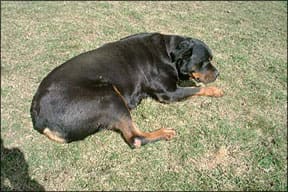
288
“For example,” she says, “if you’re treating a squamous cell carcinoma in the mouth, you may not have time to give the oral dosing and wait to see what happens. Some tumors are so fast-growing that you can literally watch them increase in size from one day to the next. If you start with oral Neoplasene and don’t see results right away, you can switch to the topical salve, which works immediately. Multiple treatments are often required at 7- to 14-day intervals. The same is true for Neoplasene that’s injected into tumors.”
Clinical guide
To help veterinarians use Neoplasene correctly and help their clients understand what to expect, Dr. Fox provides a clinical guide for the treatment of neoplasm (abnormal tissue growth or tumors), proud flesh (soft, swollen, granulated tissue that develops over large surface wounds, especially in horses), and warts. Instructions for use precede case histories from a dozen holistic veterinarians, complete with graphic photos.
Conventional cancer treatments like surgery, chemotherapy, and radiation therapy often fail to remove or destroy active cancer cells while they simultaneously damage healthy, nonmalignant tissue.
“This often leads to failure,” says Dr. Fox, “and the stoic acceptance that all that can be done has now been done, and euthanasia or animal suffering is inevitable. What has been needed is a drug that causes the destruction of all neoplasm, preferentially sparing healthy cells. Neoplasene’s isoquinaline alkaloids appear to present just this effect.”
According to Dr. Fox, the active principle in bloodroot’s main alkaloid, sanguinarine, interacts with DNA while inhibiting adenosine triphosphatase. “These and other demonstrated mechanisms offer clues to the ‘how does it work on neoplasm?’ questions,” he says. “There is a functional relationship between the death of neoplastic cells and exposure to Neoplasene.”
The cases documented in Neoplasene’s clinical guide include sarcoma, melanoma, osteosarcoma, mammary tumors, malignant liposarcoma, mixed cell chest tumors, malignant fibrosarcoma, papilliferous cyst-adenocinoma, nerve sheath tumors, spindle cell carcinoma, and various other tumors and growths in dogs, cats, and horses. The graphic color photos that accompany the case studies put wound treatment warnings into perspective; this therapy is not for the faint of heart.
Not without side effects
“I’ve been using Neoplasene for a year now,” says Linda Faris, DVM, of Overland Park, Kansas, “and I’m very impressed with the results. My preference is definitely for the oral product. This is a liquid that you place in a capsule just before giving it to the pet with food. I usually give my clients enough to treat their animals for a month and then check on their progress.”
Dr. Faris acknowledges that injectable NeoplaseneX and topical Neoplasene can be highly effective, but she approaches both with reservations. “I’ve used the injectable version with mixed results,” she says. “For a couple of my patients it proved too caustic, and they had anaphylactic reactions. These reactions seem linked to repeated exposure and individual sensitivities, but in general, I think the chances of having an adverse reaction are greater for the injectable or intravenous version. I’m also reluctant to use the topical salve because of resulting wound care management issues.”
The most common side effect that Dr. Faris’s patients experience with oral Neoplasene is nausea. “Some pets throw it up soon after they swallow it,” she says. “That’s the only adverse effect I’ve seen, and we either lower the dose or stop the treatment for those animals. In some cases, if we stop treatment for a while, we are able to start it back up with no problem.”
Occasionally, Neoplasene is Dr. Faris’s first choice for economic reasons. “Some clients are on such a tight budget,” she says, “that other treatments are just not affordable. Neoplasene isn’t free, but it’s far less expensive than conventional cancer therapies and most alternatives.”
One of her favorite success stories involves a small female Poodle with perineal adenocarcinoma that was impinging on her rectal canal. Thanks to oral Neoplasene, the tumor softened and shrank, and the dog is doing well.
“This was a serious case,” says Dr. Faris, “because the tumor was beginning to interfere with her ability to defecate. Within a month, the tumor had softened and changed shape, and with continued oral Neoplasene, it shrank. She’s now on a maintenance dose of a small amount three times a day, and sometimes she only gets it twice a day. The prescription is for one-third of a c.c. every eight hours, and that’s all this dog is on.”
Holistic treatment required
For the dog’s caregivers, an effective treatment that’s easy to administer and costs only $40 per month is a blessing.
More typical of Dr. Faris’s patients is a Chow Chow with very advanced metastatic liver cancer. A multi-pronged approach is most effective in severe or advanced cases like hers.
“We’re using several different treatments, not just Neoplasene, to try to manage the cancer,” Dr. Faris says. “Last August the dog was given a 30-day prognosis, her condition was so serious. The surgeons who opened her up decided not to operate. Instead, they sent her home to die.
“Today, eight months later, you can’t tell she’s ever been sick. She honestly shows no symptoms. Her blood work is a mess, but you’d never know that by looking at her. She’s active, happy, and leading a perfectly normal life. She has had to go off the Neoplasene a couple of times because of digestive upsets, but she’s on it most of the time, along with Chinese herbs, glutathione therapy, alpha lipoic acid, liver support products like milk thistle, and a few other things.”
All of Dr. Faris’s cancer patients are on a no-grain diet that’s as low in carbohydrates as possible. “I find that really makes a difference,” she says.
Whenever she sees a cancer patient, Dr. Faris’s goal is to extend the animal’s life while improving the quality of that life. “Some dogs with cancer don’t come to me until they’re at end stage,” she says. “Unfortunately, I’m not able to do much except ease their transition. But those who come to me in time typically do very well.”
Spreading the word
In addition to seeing her own patients, Dr. Faris consults with veterinarians around the world.
“In one case a woman in Great Britain got in touch with me because of an article I’d written about a case similar to that of her Northern Inuit. The dog had advanced histiocytic sarcoma, with large tumors that were actually rotting on her body. She had already been put on chemotherapy, but it made her so ill that they had to stop.
“Through the help of her local veterinarian, we were able to put the dog on Neoplasene and European mistletoe, another herb with cancer-fighting properties. That dog is a miracle. The tumors have all healed and regressed to nothing. Now, just a few months after she started treatment, you can’t tell she has cancer.”
For as long as people have been experimenting with black salves, some have taken them orally once or twice a year as a cancer prevention therapy. Dr. Faris considers a similar use of oral Neoplasene a sensible strategy for dogs at high risk of developing cancer or experiencing a recurrence.
According to Dr. Fox, since its introduction four years ago, over 2,000 veterinarians worldwide, most of them in the United States and Canada, have prescribed Neoplasene for their cancer patients. “Considering that a single jar of the salve will treat 80 cats or a large number of dogs,” he says, “this is a very affordable therapy.”
In August 2006, New York City veterinarian Jill Elliot, DVM, told the New York Post that Neoplasene was changing her medical practice. One of her patients, a 10-year-old Belgian Shepherd named Athos, had been given six months to live by oncologists who removed his cancerous tumor. Dr. Elliot combined conventional and homeopathic treatments to keep Athos in remission until July 2006, when a new tumor appeared.
Dr. Elliot injected the growth with NeoplaseneX, and almost immediately, the tumor began turning white. “About five hours later,” she said, “the sick tissue was literally dying and dripping off. This is so miraculous that I’m fully endorsing Neoplasene. With results like this, it’s worth devoting the rest of my practice to it.”
CJ Puotinen is author of The Encyclopedia of Natural Pet Care, Natural Remedies for Dogs and Cats, and other books. She lives in New York with her husband, a Labrador, and a tabby cat.
Ongoing Pet Food Recalls
Who could have imagined a month ago how the pet food recall could implode like this?
This started in mid-March, when Menu Foods, a contract manufacturer of wet pet foods, announced it was recalling dozens of products containing wheat gluten, which was traced to a new source in China. A fortnight later, investigators identified a contaminant, melamine, a chemical used in plastics.
Once the source of the ingredient was known, investigators sought to locate every place the ingredient had ended up – and the pet food recall expanded as more products made with the contaminated wheat gluten were found. As we went to press with the May issue, it seemed possible that the contamination of wheat gluten was limited to a sole shipment, and the number of places where the ingredient was used was finite – if not yet fully identified.
Just days later, that idea was disproved, as a number of dry pet foods, biscuits, and treats were found to have been made with the Chinese wheat gluten. The recall expanded day by day.
Then, an even more frightening shift in the news occurred, as reports surfaced that both corn gluten and rice protein concentrate sourced from China had also been found to contain melamine.
The news was the number one topic of conversation at Petfood Forum, a trade association conference held in Chicago in mid-April. The experts seemed most shocked about the discovery of contaminated rice protein; this is considered a “quality” ingredient, expensive, and is not in wide use in mass market pet food like corn gluten or wheat gluten. Suddenly, even the makers of “super-premium” pet foods – who had no doubt been relieved previously that the problems seemed limited to a different segment of the market – were scrambling to trace and test their ingredient sources. The most frequent comment I heard at the conference was “it could happen to any one of us.”
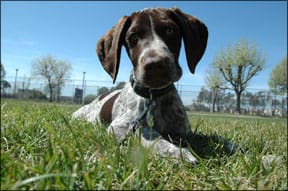
288
Each day has seen dozens more foods added to the recall list. The latest news, as this issue is going to press, is that hundreds of foods that don’t (according to their labels) contain any of the suspect ingredients are being recalled by Menu Foods (where they were manufactured) due to “cross contamination.”
Currently, there are thousands of recalled products – too many to list in our pages. Websites published by dog enthusiasts seem to offer the latest-breaking news of expanding recalls, including sites such as petfoodtracker.com, petconnection.com, and itchmo.com. If you don’t have internet access, contact the manufacturer of each of your dog’s foods and treats and ask if the products you have bought and fed to your pets have been recalled.
“An Open Secret” in China
On April 30, the New York Times broke the story wide open. Reporters for the paper visited chemical plants in northeast China that make melamine from coal – and sell it to companies that manufacture plant-based proteins.
The Times reporters learned that the Xuzhou Anying Biologic Technology Development Company, one of the companies that American regulators named as having shipped melamine-tainted wheat gluten to the United States, had posted ads on industry websites in China, looking for sources of melamine to use in their products.
The reporters also spoke to two animal feed producers who told them that the use of melamine in plant-protein products is common in China. Inclusion of the product in small amounts “fools” the tests used to determine the protein content in the ingredient, making it appear that the protein levels are greater than they actually are; the higher the protein, the higher its value, and the higher its profits.
What are they good for?
Many dog owners, reeling from the daily bad news, are still trying to figure out what plant-based proteins are doing in carnivore food –especially in high-priced, presumably top-quality foods.
Plant proteins are mainly used to boost the protein content of some pet foods, though they may also contribute other functions. As discussed in “Pet Food Disaster,” May 2007, wheat gluten is widely used to thicken and “bind” the processed “chunks” or “cuts” of ground and mixed meat and grain material (known as “meat analogue”) used in wet “cuts and gravy” food products.
Corn gluten is frequently used to complete the desired amino acid profile of the finished product in an economical way. Wheat gluten costs about two to three times as much as corn gluten.
Rice protein concentrate is considered a higher-quality plant protein than wheat gluten or corn gluten, as it contains more of the amino acids needed by dogs and cats and is more digestible. It’s generally more expensive than wheat gluten, and even costs more than some animal proteins.
In low-cost foods, plant proteins (especially the extremely inexpensive corn gluten) are frequently used as a less-expensive alternative to a higher inclusion of animal proteins.
In higher-end foods, plant proteins are sometimes included when a manufacturer is seeking to provide a sole source of animal protein in the product, but the species used cannot provide as much total protein as is desired in the formula. They may also be used when including more of the animal protein source would contribute too much of another nutrient, to potentially harmful levels.
This is often the case with lamb- or venison-based foods. Lamb and venison meal are lower-protein meals, with higher ash levels, and have a moderate risk of going rancid. Ash is present in these ingredients in proportion to the amount of bone included in the meal. Low-ash meals are available, but the price is very high. These meals are also very high in fat, which presents another problem for the formulator who is trying to increase the product’s protein without increasing the fat level too much.
This is why manufacturers will often supplement their lamb- or venison-based products with rice protein concentrate (which is higher in protein, lower in ash, and is a more stable product) to help achieve the desired protein levels while maintaining safe ash levels and decreasing the risk of rancidity.
Rice protein may also be used in foods that are formulated for animals who are allergic to or intolerant of animal proteins.
In our opinion, the inclusion of rice protein in a food is not a problem – unless the ingredient is contaminated with melamine! And the only way that the inclusion of melamine-contaminated rice protein in a food could be even worse news for a company is if “rice protein” wasn’t on the list of ingredients on a pet food label.
We’ve been telling people to read dog food labels since Whole Dog Journal’s inception. But what’s a consumer to do if the label doesn’t list what’s actually in the food?
Inaccurate labels
When Natural Balance announced that it was recalling four of its foods, saying that the products contained rice protein concentrate found to contain melamine, our immediate response was “What?” The labels of the named products did not list rice protein as an ingredient. The company said in its April 17 press release that the ingredient had only recently been added to some production runs of the four products. The ingredient lists of the four foods were quickly changed on the company’s website to reflect the inclusion of rice protein, but of course the bags and cans of food already in stores (and people’s homes) did not.
Most pet food companies fiddle with their ingredients from time to time, adding a bit of this or that, or removing ingredients that are difficult (or prohibitively expensive) to source or that pose processing challenges. But they are legally obligated to immediately update the package labels of the reformulated products to accurately reflect their contents.
There is a persistent myth that every pet food executive has heard (and many may have repeated), to the effect that federal labeling laws allow pet food makers a “grace period” of six months, in which they can change the ingredients of their foods without changing the label. This is not true.
Another shoe dropped when American Nutrition, the contract manufacturer that made Natural Balance’s wet foods and baked treats, announced a recall of 26 wet pet foods and two baked dog treats after learning that the rice protein it used in the foods was contaminated with melamine. Four foods not previously recalled by
Natural Balance were on American Nutrition’s recall list. Natural Balance issued a press release the same day, stating that American Nutrition had added rice protein to these four products without the consent or knowledge of Natural Balance. Canine Caviar, a company with two products on American Nutrition’s recall list, and Blue Buffalo (with nine products on the American Nutrition list), and others also have denied having any knowledge that rice protein was added to their foods.
American Nutrition has since published its own press release in response, saying (in part): “American Nutrition did not engage in any deliberate or intentionally wrongful conduct relative to the inclusion of rice protein in certain products it manufactures . . .
“American Nutrition is investigating the circumstances surrounding labeling, formulation, and related inter-company communications, but it is simply false to state that American Nutrition was engaged in any deliberately deceitful and/or unlawful conduct. Labeling responsibility is a cooperative effort between American Nutrition and its customers. American Nutrition believes, for their part, that they were compliant with all applicable label regulations. Additional information will be released as American Nutrition completes its own investigation and as they continue to cooperate fully with ongoing FDA and other governmental agency inquiries.”
I’ve toured American Nutrition’s cannery, and I’m aware that their computers and technicians generate “batch records” that note the amounts of each ingredient used as batches of food are mixed and cooked. Some pet food companies require copies of these records and actually review them. Usually, any deviations from the formula given to the co-packer must be approved by the pet food company whose name is on the label. In my opinion, it’s a bit disingenuous for a pet food company to claim they didn’t know what a co-packer was putting in their food.
But on the other hand, what are we to make of the “cross-contamination” claimed by Menu Foods?
We’re frustrated, given that we’ve spent 10 years telling our subscribers to read product labels – and make purchasing decisions based on the ingredients that are on the labels. Now, it seems to be developing that “what’s in the bag” (or can or pouch) is accurately described by the product labels only sometimes. The industry owes consumers some solutions; how can we ever trust that what’s in the package is what the label says it is?
This incident opens another can of worms – or we should say, reopens. Lawsuits were only recently settled following a 2003 dog-killing recall involving food made by a contract manufacturer that evidently didn’t contain what its labels said it contained. The co-packer pointed a finger at the formula provided by the pet food company, the company blamed the co-packer, and, thanks to the sealed nature of legal settlements, we’ll never know who or what was truly at fault.
Bring on the revolution!
Problems frequently present an opportunity for growth or change, and the crisis in the pet food industry is no different.
Eager to win back the trust of concerned buyers, pet food companies are putting far more rigorous quality-control practices into immediate use. Some are “embedding” company staffers at contract manufacturing facilities. Some are seeking their own manufacturing facilities. I’ve heard from a number of pet food companies who are pledging to begin using U.S.-sourced ingredients only. Everyone has stepped up their procedures for sourcing and testing their ingredients.
While we’re glad to hear about these planned improvements, we have to be a bit skeptical. How will the companies involved prove to us that these things have been accomplished?
I’m thrilled to hear that thousands of people (including Oprah Winfrey!) have started feeding their dogs home-prepared diets. I hope that Whole Dog Journal will help inform the people who stick to the practice over the long haul, to prevent health problems related to nutritional deficiencies, excesses, or imbalances caused by poorly designed diets or adherence to a single recipe.
Author Mary Straus has been slaving over our series of articles on the nuts and bolts of home-prepared diets for more than six months. The first one in a planned series of five or six articles appeared very fortuitously in our April issue; the third installment appears on page 3 of this issue.
In the long run, owners will have to determine where on the scale of fear and trust they stand. Guardians who have little faith in the pet food companies and much fear about commercial products will have little choice but to begin making home-prepared diets for their pets. Those on the other end of the scale – with little fear and lots of trust – will keep buying the products they and their dogs like. And many of us will probably take a middle path – at least until the recall headlines stop appearing daily.
Dog Food Reviews Follow-Up
As a new subscriber to Whole Dog Journal, this is the first time I have received the issue that contains your recommended top quality dry food for dogs (February 2007). I was surprised that Solid Gold was not part of your list. I recently lost a 14-month-old Golden Retriever to cancer. Since that experience, pet food quality is my top priority for my dogs.
Marie Camirand Montreal, Canada
Solid Gold’s products did appear on our lists of “top dry foods” and “top wet foods” (March 2007). The dry products we highlighted were listed under their names: Hund-N-Flocken and Mmillennia.
I feed my three Border Collies Flint River Ranch food with an occasional treat of The Honest Kitchen and they are doing great. However, I noticed that Flint River Ranch was not on your list this year. Can you tell me why?
Barbara Berg Via e-mail
My sincere apologies for not explaining the omission of FRR’s dry food this year. As far as I know, nothing has changed about the food’s ingredients or manufacturing; it still meets our selection criteria. But every year I receive complaints from readers who are frustrated by the management style/business structure of this multi-level marketing company. Consumers either get no response, or a poor response, when they try to reach the “home office” – the people responsible for formulating and making the food. Consumers with questions or concerns about the pet food are encouraged, instead, to bring their questions to an independent distributor of the food near them. Often, these independent agents are unable to answer consumers’ questions about the food – and are even sometimes unable to find out the information from the “senior distributor” above them, much less the company representatives.
Recent events have demonstrated how important it is to be able to quickly and easily contact the maker of a dog food, to report problems, have confidence that the problems will be recorded and considered, and to receive quick and reliable answers to urgent questions. It’s been our experience, and that of many of our readers, that the folks in FRR’s corporate office discourage interaction with consumers. Given this persistent complaint, I decided to stop listing the products; it was no reflection whatsoever on the products themselves.
A phone number, please, for the company that sells Bioflow magnetic therapy products for dogs (as mentioned in “Help Rover Get Over It,” April 2007)? It’s incredibly annoying for those of us who don’t have a computer (and don’t plan to get one!) when only a website or e-mail address is given for a company or person.
Via e-mail
I’m very sorry about that; we usually take pains to include a phone number, not just a website address, for the companies whose products we recommend. The company can be reached (in the United Kingdom) at 011-44-155-939-5477. The address is Magnetise, Bwlch Bychan Farmhouse, Brynteg, Ceredigion, SA40 9UY.
The 5 Most Common Dog Training Mistakes
[Updated December 26, 2018]
You’ll never hear me say that coercive dog training methods don’t work; they can. Nor will you ever hear me say that positive training turns every dog into a model canine citizen. It doesn’t.
There is a big difference, however, between positive and coercive dog training. When methods that rely on the use of force and application of pain fail, it’s often because of the dog’s inability to tolerate coercion and intimidation. This can result in serious long-term behavioral damage and sometimes physical injury.
Dogs at the assertive end of the canine personality continuum may fight back assertively against coercive techniques, while those who are too soft to tolerate physical punishment may bite defensively or simply shut down. Positive dog training methods, however, are most likely to fail because of mistakes made in the implementation of the method. If you misuse your clicker (clicker training) and treats you may end up with a fat, happy, out-of-control dog, but you’re far less likely to do any long-term physical or psychological damage.
The ideal, of course, is to have a healthy, happy, well-behaved dog. In order to accomplish this with positive training methods, you’ll want to be sure to avoid the common mistakes described below.
Mistake #1: Confusing Positive Conditioning with Permissiveness
You may hear non-positive trainers insist that there has to be a negative consequence for a dog’s inappropriate behavior or he’ll never learn what’s not allowed. It might surprise you to hear that positive trainers don’t disagree. We just differ on the nature of the consequence. A well-implemented positive training program combines good management, to prevent the dog from having the opportunity to be reinforced for undesirable behavior, and negative punishment, in which the dog’s inappropriate behavior makes a good thing go away. Consider this comparison:
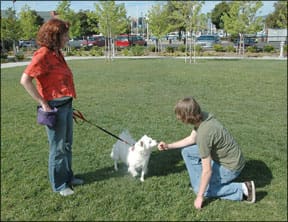
Coercive dog training – Dog is on leash, goes to jump up on an approaching pedestrian. Handler gives a sharp correction (punishment) by jerking hard on the leash. Jumping up is punished; dog learns that bad things happen if he tries to jump up. Note that he may also learn that approaching people makes bad things happen, a possible foundation for future aggressive or fearful behavior with strangers.
Positive dog training – Dog is on leash, goes to jump up on an approaching pedestrian. Handler restrains dog so he can’t reach the stranger, and asks the stranger to stop and wait for the dog to sit before petting. Jumping up is managed; dog learns that jumping up gets nothing, but sitting makes good things happen, a foundation for future good manners/ polite greeting behavior.
Permissive dog training – Dog is on leash, goes to jump up on approaching stranger. Handler allows dog to jump up and stranger pets dog. Jumping up is reinforced; dog learns that jumping up makes good things happen, and will continue to jump up to greet visitors, perhaps even intensify his efforts to jump up.
Management plays a vital role in the “positive doesn’t equal permissive” piece of positive training. By removing the positive reinforcement for unwanted behaviors, you prevent your dog from being rewarded by them. This is true whether you’re restraining with a leash to prevent jumping up, crating to stop adolescent house-destruction, clearing tables to manage counter-surfing, putting tempting objects out of reach to avoid chewing, or any of a long list of other management applications.
Behaviors that aren’t rewarded in some way eventually extinguish, especially if you make it a point to reinforce an alternative and preferably incompatible behavior.
Mistake #2: Dependency on Luring
Unless you’re a dedicated pure shaper, if you train with positive methods you probably use luring to some degree.
Luring is using a treat to show your dog what you want him to do. To lure a “down,” for example, hold the treat in front of your dog’s nose while he’s sitting, then lower it a tiny bit toward the floor. As his nose follows the tidbit, “mark” the behavior that you want with the click! of a clicker or a verbal marker, such as the word “Yes!”, and feed him the treat.
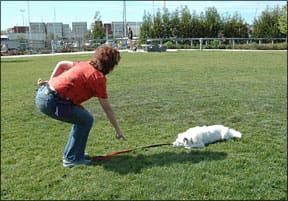
Continue gradually moving the treat toward the floor, clicking and treating along the way, until he’s lying down. If at any time he stands up, say “Oops!” and have him sit again, then resume luring the down, moving the treat toward the floor in smaller increments this time.
Luring to teach behaviors is just fine. Forgetting to “fade” (gradually remove) the lure is not. If you don’t fade the lure early in the training process, you and your dog can become dependent on the presence of treats to get the behavior to happen. While I almost always have treats in my pockets or close by, I don’t want to have to rely on treats to get my dog to offer behaviors when I ask for them.
Here’s how to fade the lure with the “down” behavior:
1. Use the lure until the “down” happens easily – when you lure to the floor your dog follows into a down position immediately, with one click! and treat at the end. For most dogs this should only take a half-dozen or so repetitions.
2. Stand in front of your dog with your hands at your sides, a treat in the hand you’ve been using to lure with. If your dog mugs that hand for the treat, hide it behind your back.
3. With your dog sitting in front of you, ask for the “down.”
4. Wait a second or two, and if he doesn’t lie down (he probably won’t), lure him to the ground.
5. Repeat Steps 3 and 4 several times, sometimes waiting a little bit longer to lure, sometimes a little shorter.
6. If he’s not lying down when you ask after a half-dozen repetitions, start fading the lure in gradual steps. Ask for the “down,” pause, and when you lure, instead of moving the treat all the way to the floor, move it three-quarters of the way, and then whisk it behind your back, parallel to the floor (if you lift it up you’ll lure him back into a sit). Since he’s three-quarters of the way down, he’s likely to continue all the way to the floor, even though the treat is gone. If not, repeat again and go seven-eighths of the way to the floor.
7. Repeat Step 6, gradually decreasing the distance you lure toward the floor, until you’ve faded the lure completely.
You can apply this same process to any behavior you teach initially by luring. As soon as the dog can perform the behavior easily for the lure, begin fading. You are, in essence, translating for your dog, showing him that the word you’re using is the equivalent of the lure. When you say the verbal cue “down,” pause, and then lure, it’s as if you’re saying, “Dog, the word down means exactly the same thing as putting the treat in front of your nose and moving it toward the floor.”
Mistake #3: Dependence on Treats
Even if you do a good job of fading the lure, you can still find yourself dependent on treats – feeling like you have to click! and treat your dog every time he performs, or the behavior might go away.
This is known as a continuous schedule of reinforcement (CSR). Dogs can achieve superb, reliable behaviors on a CSR, but the behaviors are probably not very durable. If for some reason you stop giving a click! and treat for each repetition of the behavior, the dog will probably stop doing as you ask in fairly short order, since he no longer gets his primary reinforcer (the food).
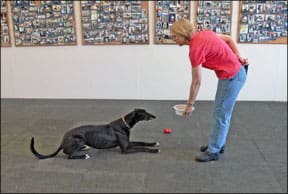
Enter the very important concept of intermittent reinforcement. When your dog performs reliably on a CSR, that is, offers the desired behavior in response to your cue at least eight out of ten times, it’s time to start reinforcing intermittently. In plain English, that means every once in a while you skip a click! and treat, and praise your dog instead. At first just skip an occasional click!, and as you practice this, over time you can skip more and more, until your dog works primarily for praise (or other life rewards).
If you include praise regularly as part of your clicker training – click!, treat, “Good dog!” your dog will have a very positive association with praise, and it will still have value even when the click! and treat are absent.
Note: In my training, a click! always means a food treat is coming. When I start using intermittent reinforcement, I don’t click! if I’m going to use praise alone. This helps to maintain the value and power of the clicker.
You can use other rewards as well, when you want to reinforce without a click! and treat. Anything your dog loves can be used as a reinforcer if you can figure out how to control your dog’s access to it and use it to reward desirable behaviors: a ball, a favorite toy, a car ride, a walk on-leash, or a scratch behind the ear.
Sometimes I reinforce my dogs for waiting politely at the door by opening the door and telling them they can run through. They get to dash outside and poop, pee, and play. These are all valuable “life rewards” – things that are naturally reinforcing to dogs.
Of course, sometimes they don’t get to run out the door. Intermittent reinforcement makes a behavior very durable. Like a gambler at a slot machines, your dog will keep playing the game because he’s learned it will eventually pay off.
Mistake #4: Poor Timing
Some trainers will tell you the consequence must happen within “x” amount of time in order for it to be effective; that is, in order for the dog to understand the connection between the behavior and the reward (or punishment). I’ve heard as much as five seconds (which I would suggest is far too long) and as little as one second (which is much more likely to be accurate).
Suffice it to say that the results are optimal when the consequence happens as close to the instant the behavior happens as possible. This is true whether the consequence is positive reinforcement (treat, praise, toy, play, petting), negative punishment (where the dog’s behavior makes a good thing go away), or “positive punishment” (where the dog’s behavior makes a bad thing happen). Of course, positive trainers studiously try to avoid using positive punishment.
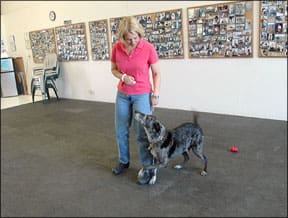
The greatest value of a reward marker – such as the click! of a clicker or the word “yes!” – is that it enables you to have perfect timing. With a marker, you can always have perfect, or at least near-perfect timing, because the marker bridges the time gap between the behavior and the delivery of the treat. Of course the marker still has to be given the instant the behavior happens – or very close thereto – but it gives you a few seconds of breathing room in which to deliver the treat.
If you have poor timing, you may inadvertently but consistently reinforce a behavior other than the one you want your dog to perform. At best, this is confusing for the dog, slows learning, and is frustrating for both of you. At worst, you might reinforce the exact opposite of the behavior you’re trying to teach, and end up training your dog to do an entirely different behavior, perhaps even a highly undesirable one!
Let’s say you’re trying to teach your dog the polite greeting behavior of “sit” when he approaches visitors in your home. When your guests arrive, you have him on leash so you can manage his jumping up behavior. As your first guest enters the door, your dog executes a brilliant “sit” on the doormat! You fumble for your clicker, and just as you press the metal tongue he decides he’s not getting reinforced for the sit and jumps on Aunt Martha. Click! – and major oops! Of course you haven’t done terminal damage – unless Aunt Martha is 90 years old and breaks her hip when your dog knocked her down. But every time you’re too slow with your marker and it arrives when your dog is jumping up instead of sitting, you’re telling him that jumping is a good thing to do; it earns a marker and reward!
Herein lies one of the values of having a verbal marker, such as the word “Yes,” or a clicking sound you make with your tongue. If you’re caught off guard and you don’t have your clicker handy – just let loose your verbal marker and follow with one of the treats you always have in your pocket.
If you realize your timing is sloppy even with your clicker ready in hand, then do some clicker-timing practice. With your dog out of earshot, turn your television onto the sports channel and find a tennis match. Watch closely. Every time a player hits the ball, click! your clicker. When your click! regularly coincides with the “Thwack!” of the ball hitting the racket, you’re ready to go back to work with your dog. (Note: this sort of practice isn’t nearly as effective with golf or baseball.)
Mistake #5: Lacking Sufficient Courage of Your Convictions
When you’re training your dog and things don’t seem to be working as they should, it can be tempting to let yourself be led astray. You can always find a ready supply of friends, family members, and other animal care professionals who are happy to tell you that you need to correct, alpha roll, intimidate, and/or shock your recalcitrant dog into submission.
Perhaps you’re a crossover trainer and even your own past success using forceful methods prompts that little voice in your brain to say, “I could just jerk his collar one time…”
STOP!
One of the things we value so much about positive training is the trust it builds between dog and human. Your dog trusts that he can try behaviors without getting hurt – you’ll let him know when he’s right, but you won’t frighten or hurt him when he’s wrong. When you violate that trust, you risk negative behavioral consequences that are sometimes significant, ranging from aggression at one end of the spectrum, to shutting down, or learned helplessness, at the other.
When a dog becomes aggressive, his future becomes questionable. When a dog shuts down, losing his willingness to offer behaviors for fear he’ll be punished, it makes his training even more frustrating.
Aggression aside, using coercion along with positive training has serious consequences. If you punish your dog for failing to perform a cue that you “know” he knows, you “poison” that cue; in other words, you give him a negative association with it. The cue becomes ambiguous; the dog doesn’t know if it predicts “good stuff” (click! and treat) or “bad stuff” (punishment). This ambiguity creates stress, and can turn a happy working dog into one whose tail starts to lower and enthusiasm starts to wane.
A poisoned cue is very difficult, if not impossible, to rehabilitate. If you poison a cue you’re better off introducing a new one than trying to regain the consistently positive association with the old one.
You always have a choice as to how to behave with your dog. One of the many things I love about positive training is that if one way isn’t working, there are many more possibilities to try to get the behavior you want to reinforce, without resorting to coercion or intimidation. Use of force in an otherwise positive training program is detrimental to future training, as well as evidence of lack of creativity and lack of commitment to a pain/intimidation-free relationship with your dog.
At a recent seminar, the owner of a lovely Bernese Mountain Dog admitted to me that he “had” to use a forced retrieve (ear pinch) on his otherwise positively trained dog. I gently suggested that he didn’t “have” to, but rather he “chose” to use this pain-inducing method. I wasn’t surprised when we got to the shaping exercise in the seminar and the Berner sat next to his owner, staring unwaveringly into his eyes, not offering a single bit of behavior, while the rest of the dogs in the group happily engaged in the shaping game and learned to move toward, and eventually onto, their mats. His choice definitely affected his dog and their relationship.
Positive works. If you’re committed to positive training, you can find a way to teach a retrieve without pinching your dog’s ear, or overcome your own training challenge. There are plenty of great books, videos, positive trainers, and supportive e-mail lists that can help you through your training program. Or you can decide that teaching the retrieve isn’t important enough to lose your soul over, and find something else to do with your dog that doesn’t “require” the infliction of pain. It’s your choice. Choose wisely.
DOG TRAINING MISTAKES: OVERVIEW
1. Review your own training program to identify which of the training mistakes you might be making.
2. Implement changes to your training protocols to help you avoid the mistakes and improve the efficacy of your training.
3. If necessary, renew your commitment to positive training methods that encourage a relationship between you and your dog based on mutual trust, cooperation, and respect.
Special thanks to trainers Ruthanna Levy of Alameda, CA, and Sarah Richardson of Chico, CA, for demonstrating proper positive training techniques for this article.
Pat Miller, CBCC-KA, CPDT-KA, is Whole Dog Journal’s Training Editor. Miller lives in Hagerstown, Maryland, site of her Peaceable Paws training center. She is also the author of The Power of Positive Dog Training and Positive Perspectives: Love Your Dog, Train Your Dog.
Canine Allergies and Your Dog’s Health
Ask a dozen health experts about allergies and you’ll get at least that many theories about what they are, why they happen, and how to fix them.
What’s interesting is that even when they disagree, most allergy theories point to the same underlying causes. This is because allergic reactions are symptoms of a deeper imbalance. Dogs don’t develop allergies because they are exposed to allergens. Dogs are exposed to allergens all the time, usually with no reaction. Dogs develop allergies with implications of skin problems because something has made them vulnerable, and the culprit is often a combination of diet, stress, conventional medical treatments, heredity, and environmental factors.
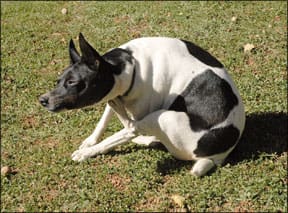
Four months ago we explored Candida albicans (“Canine Candida,” February 2007), considered by some to be a major factor in canine allergies. This article explores the links between canine allergies and leaky gut syndrome, a different species of yeast called Malassezia pachydermatis, and detoxification support.
Leaky Gut Syndrome in Dogs
Also known as intestinal permeability, leaky gut syndrome is exactly what it sounds like, a condition in which damage to the small intestine creates spaces between cells in the intestinal lining, spaces that are large enough to allow fragments of partially digested food, toxins, and bacteria to migrate from the intestinal tract into the bloodstream. The results include impaired digestion, incomplete absorption of nutrients, and the presence of what the immune system identifies as foreign invaders throughout the body. The immune system responds with its usual weapons, which produce inflammation and allergic reactions.
Soon the liver and kidneys, the body’s main filters, become overwhelmed, and toxins spill over into the bloodstream, which carries bacteria, toxins, and partially digested food particles to muscles and connective tissue throughout the body. Leaky gut syndrome is blamed for respiratory and skin allergies, arthritis, irritable bowel disease, autoimmune disorders, diabetes, and a host of other problems.
Leaky gut syndrome is a vicious cycle. Something (usually diet-related) causes injury to the small intestine, resulting in impaired digestion, which leads to bacterial overgrowth and other problems, resulting in further damage, and the cycle continues. Some of the conditions blamed for leaky gut syndrome include high-carbohydrate diets, antibiotics, parasites, yeast or fungal infections, nonsteroidal anti-inflammatory drugs, and mineral deficiencies. Some of these, such as parasite infestations, yeast or fungal infections, and mineral deficiencies, can result from the syndrome as well as help cause it.
At Reinhardt Ranch Holistic Nutrition Center for Pets in Elk Grove, California, nutritional consultant Elaine Reinhardt hears every day from people whose dogs have chronic allergies. “Leaky gut syndrome is at the root of many illnesses,” she says, “including autoimmune diseases, joint diseases, and allergic reactions. Since much of your immune function is in your gut, it makes sense to look there first. Certainly this is true when it comes to allergies.”
A large number of the dogs she works with were adopted from shelters or rescue groups. Most, she says, are underweight. Even in their new homes and on an improved diet, they can’t gain an ounce. Reinhardt suspects that conditions that interfere with their gaining weight, such as leaky gut syndrome and malabsorption, contribute to behavioral problems, hyperactivity, and other factors that prompted their previous owners to give them up. “Add all the health problems that come with leaky gut syndrome and an inflamed intestinal tract,” she says, “and the expense of conventional medical treatment, and I suspect that many of these dogs were given up because their owners couldn’t afford the time and expense their treatment required.”
Symptoms as varied as ear infections; seasonal or respiratory allergies; itchy skin; hair and coat problems; diarrhea; and an inability to gain weight can all stem from digestive problems, she says.
To heal the digestive tract, Reinhardt recommends an improved diet with higher-quality protein and the elimination of soy, corn, wheat, and chicken fat. “Soy, corn, and wheat are at the top of the list of foods that irritate canine digestion,” she says, “and I like to stay away from chicken fat because it contains residues of whatever the chicken was exposed to in the way of drugs and toxins. Fat from organically raised, pastured chickens is fine, but that’s not what you’ll find in commercial dog food.”
Reinhardt then recommends three supplements that she considers crucial for rapid healing and recovery: Seacure, probiotics, and digestive enzymes.
Seacure, described in “Securing Seacure” (April 2003) and “Accelerated Wound Healing” (August 2006), is a very fishy smelling powder made from fermented deep sea white fish. Because the fermentation process predigests the fish and breaks it into amino acids and peptides, which the body uses as building blocks to repair damaged tissue and speed healing, it requires no digestive effort and is assimilated on contact.
“I started taking Seacure seriously,” says Reinhardt, “when I gave it to some cats who were dying. They literally responded within 15 minutes. Their eyes went from dull to sparkling in that short a time. Since then, I’ve seen the same response again and again, including seriously ill and unresponsive dogs who sat up, began grooming themselves, wagged their tails, interacted with their owners, and took an interest in their surroundings, all within 15 minutes. I’m not saying that they all get well, but when any pet in dire straits responds dramatically, it’s wonderful.”
In most cases, she says, underweight dogs and dogs with allergy symptoms begin to improve within a few days, and within a month or two, they have gained weight, their coats have improved, bald spots have disappeared, and they no longer chew on their paws. “The food that goes in stays in,” she says. “It doesn’t come shooting out the other end as bright yellow diarrhea. Seacure provides the deep nourishment that helps with conditions across the board.”
Reinhardt usually starts with the label-recommended dose of ¼ teaspoon per 10 pounds of body weight per day, but for dogs weighing over 100 pounds, she finds that 2½ teaspoons works well. “Larger animals don’t necessarily need a greater dose,” she says, “and dogs who don’t need a lot of digestive support do well on half the recommended dose.”
Reinhardt says that when she adds probiotics (beneficial bacterial) and digestive enzymes, the dogs’ health improves even faster.
Some probiotics (see “Probiotics Boost Canine Overall Health,” August 2006) are labeled for pet or veterinary use. Among the many strains of probiotics for which canine health claims are made, one of the most interesting is Lactobacillus sporogenes. Unlike L. acidophilus and similar strains, L. sporogenes reproduces rapidly, so it acts faster in keeping yeasts and fungi in check. Some human product lines, such as Thorne Research, carry L. sporogenes supplements, which can be safely given to dogs.
Several canine probiotic supplements, such as Jarrow Formula’s Pet Dophilus Powder, contain Enterococcus faecium, a strain that is native to dogs and which some nutrition experts consider essential to canine health.
Enzyme products that have helped dogs with allergies include digestive enzymes that are added to food, such as Prozyme and NZymes, and systemic oral enzymes, such as Wobenzym and FlavenZym, which are given between meals on an empty stomach (see “Enzyme Therapy for Quicker Canine Injury Recovery,” January 2001, and “Digest These Benefits,” October 2005).
Reinhardt prefers PetLabs360 DigestAbles tablets. “They’re chewable,” she says, “so they can be fed directly to dogs or put in their food. They’re beef and cheese flavored, so even finicky dogs like them, and the results are excellent.”
Her favorite product for dogs suffering from airborne allergens is SeaVive, a companion product to Seacure. SeaVive contains Seacure, colostrum, Beta-1,3-D glucan, and vitamin C.
Another supplement that has helped dogs with all types of allergies is Willard Water (see “Willard Water,” June 2006), which can be added to drinking water or herbal tea and diluted and added to food to improve digestion and increase the assimilation of nutrients.
Malassezia
Malassezia pachydermatis is a yeast commonly found in the ears and on the skin of dogs. Held in check by the immune systems of healthy dogs, it can multiply until it becomes pathogenic in susceptible dogs, resulting in itchy, oily, or scaly skin, hair loss, redness or blackening of the skin, thickening of the skin, and an offensive greasy odor.
Affected areas tend to be the ears and skin folds on or around the face, elbow, underarm, and tail. Dogs with an overgrowth of Malassezia may lick their feet incessantly because of atopic or environmental allergies that accompany the yeast overgrowth. Cocker Spaniels, Basset Hounds, and West Highland White Terriers are said to be especially susceptible, but any dog can experience a Malassezia overgrowth.
Malassezia yeast cells can be identified under a microscope. A skin lesion can be scraped or swabbed, or a sample can be collected on scotch tape. Conventional veterinary treatment of Malassezia usually involves a shampoo containing one or more topical antifungal medications, such as miconazole, clortrimazole, or ketocanazole. Oral anti-fungal drugs are prescribed in cases that don’t respond to topical treatment.
Holistic veterinarian Susan Wynn, DVM, thinks that Melassezia, not Candida, is implicated in many itchy dogs’ uncomfortable plight. “Malassezia is a yeast species that can cause thickened, hyperpigmented skin, bad ears, fatigue, and lethargy,” she says. “Of course, Malassezia is also a secondary problem to whatever is going on with the dog. Malassezia is the primary yeast that causes opportunistic (secondary) infections in dogs and is diagnosed regularly on the skin or in the ears. Secondary infections by Candida albicans are possible but much more rare, and most of the holistic veterinarians I know treat leaky gut syndrome instead of candidiasis.”
Dr. Wynn does not believe treatment with anti-fungal medications or herbs is always necessary before giving an affected dog probiotics and changing the dog’s diet, and she emphasizes that leaky gut syndrome can occur independently of candida overgrowth.
For Malassezia-infected ears, Dr. Wynn recommends daily cleaning with vinegar diluted with an equal amount of water, which is a gentle way to lower the pH in the ear, making it less hospitable to yeasts and fungi. A pinch of boric acid has a similar effect (as described in “A New Old Ear Treatment,” June 2004). For topical treatment of the skin, Dr. Wynn recommends Selsun Blue shampoo or the application of a 10-percent tea tree oil spray, which has proven antifungal properties.
Our literature search of holistic treatments for Malassezia produced recommendations identical to holistic treatments for candidiasis. “You’ve discovered exactly the point,” says Dr. Wynn. “And if you look further, you will discover that the treatment is very much like what we recommend for any chronic allergic or immune-mediated disease, many of them centering on abnormal gut permeability.
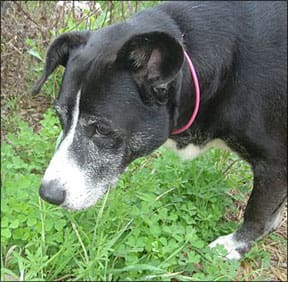
“To wit, we have diseases that respond to diet changes, probiotics, and various herbal tonics or specifics, and we can only document the presence of fungi in some cases, so we look for a different cause. This is why so many veterinary practitioners look at chronic yeast infections as a problem that pops up in immunocompromised animals and not as the primary disease. Holistic treatments like improved diet and probiotics work, but they work directly on the immune system, strengthening the body so that it resists yeast, rather than by killing the yeast directly.”
Dr. Wynn almost never recommends conventional antifungals like Nystatin for Malassezia, finding that Selsun Blue shampoos works well for all but the most serious cases in combination with holistic treatment for leaky gut syndrome.
Detoxification Support
Most of us think of detoxification as something that happens when we go on a “detox” program of fasting, herbs, juices, or supplements that speed the body’s release of impurities. In fact, detoxification goes on constantly as the body breaks down and removes waste products.
If the liver receives the nutrients it needs to perform this function well, it maintains itself in a state of health. If the process is impaired, health suffers. Unfortunately, dogs are often overwhelmed with the burden of detoxification – and undernourished by low-quality commercial diets. This combination can contribute to leaky gut syndrome, yeast overgrowth, and a variety of allergy symptoms.
During the first stage of the detoxification process (Phase I), the body’s filters identify and separate waste products and toxins from the blood and lymph. Water-soluble material gets sent to the kidneys for excretion. Dehydration complicates this process, which is why consuming clean drinking water is so important. Additional nutrients are required by the liver to perform Phase II functions, the elimination of materials that couldn’t be made water-soluble in Phase I.
When a dog is deficient in key nutrients, backups and spillovers of waste products can occur. Partially processed toxins traveling through the bloodstream may find a home in fatty tissue, or they may stay in the blood, infect healthy tissue, and cause new illnesses. Incomplete detoxification and leaky gut syndrome (and the allergy symptoms they aggravate) can be corrected with an improved diet and supplements that support the digestive tract.
Seacure, described above, is an important whole-food source of amino acids and an aid to Phase II detoxification. Digestive enzymes taken between meals help support the process. So do whole-food nutritional supplements, such as Standard Process Canine Dermal Support, which targets skin conditions, or Canine Hepatic Support, which improves liver function.
Dogs are well known for finding their own treatments when given the opportunity. Renee Votta, an herbalist in New Braunfels, Texas, adopted a mixed-breed dog she found. “We had just had a huge flood, and many animals were homeless due to houses being destroyed and animals being caught in the river. I looked for her owners but no one claimed her.”
Votta named the dog Bonnie and took her to a veterinary clinic for spaying and to have the open sores on her legs treated. “She licked at them all the time,” says Votta. “Most were an inch wide and an inch long, some smaller and a few larger. The vet said they were caused by contact dermatitis having something to do with the grass, weeds, and green things that grow here all year. The vet said we would have to live with them because it’s the kind of problem that keeps coming back.”
That winter, Votta experimented with topical treatments. A mix of aloe vera, vitamin E, and olive oil worked best, but even though the sores got smaller, they never went away and new sores often developed.
One day, Votta realized that Bonnie, standing in a weed patch, was carefully harvesting cleavers (Galium aparine). “I couldn’t get over it,” she says. “Bonnie was ignoring all the other weeds. At that moment I realized that her condition had nothing to do with external factors. Her problems were inside her.”
Votta encouraged Bonnie to eat all the cleavers she wanted from the yard, plus she made cleavers tea to add to the dog’s water. She also added minced cleavers and raw garlic to Bonnie’s dry food.
Within a month, all of the sores on Bonnie’s legs cleared up and in the eight years since, she has never had another open sore. She continues to graze on cleavers, especially when the plants first emerge in the spring. “Eating a few strands of them every so often is enough to keep her healthy and her blood clean,” says Votta.
In her book Veterinary Herbal Medicine, Dr. Wynn describes cleavers as a mildly astringent and mildly diuretic herb that is a tonic for the lymph system. It has been used for dry skin eruptions, as a remedy for ulcers and tumors, and for the treatment of psoriasis. In All You Ever Wanted to Know about Herbs for Pets, Mary Wulff-Tilford and Gregory Tilford describe cleavers as an herb that enhances the body’s waste management by improving lymphatic circulation, thus “washing” body tissues.
Because cleavers is an invasive weed with a wide range, it’s probably growing in your neighborhood. Consult a plant identification guide or search for cleavers online; several herbal websites offer descriptions and photos. In addition to having a distinctive appearance, cleavers feels sticky to the touch and clings to whatever it contacts. Avoid herbs that grow near highways, busy parking lots, or fields treated with pesticides or agricultural chemicals.
To try Bonnie’s remedy, finely chop or mince fresh cleavers and add it to your dog’s food, starting with small amounts and increasing to about 1 tablespoon minced herb per 25 to 30 pounds of body weight per day in divided doses. For convenience, store fresh cleavers in the freezer by pureeing the herb in a small amount of water, placing it in ice cube trays, and as soon as it’s frozen, transfer to a tightly sealed plastic bag. Remove a cube at a time as needed.
Dried wildcrafted cleavers can be ordered from Jean’s Greens and other herbal supply companies. To brew cleavers tea, pour 1 cup boiling water over 2 tablespoons fresh or 2 teaspoons dried cleavers, cover, and let stand until cool. Add the tea to food at the rate of 1 teaspoon tea per 10 pounds of body weight. Refrigerated tea can be kept for up to 5 days.
The Jean’s Greens tea blend Pollution Solution, which combines cleavers with elderflower, rosemary, dandelion leaf, peppermint, cinnamon, echinacea leaf, and red clover, provides gentle detoxification support and can be brewed and used in the same manner.
Whole Dog Journal contributor CJ Puotinen lives with her husband, Joel, and Labrador Retriever, Chloe, in New York.
Angry Over The Recent Dog Food Recall
Although I have received Whole Dog Journal for at least three years, I was thinking of letting my subscription lapse until I heard the terrible news of the dog food recall. If it wasnt for your newsletter I would still be feeding a terrible canned dog food (that I thought was high quality) to my two dogs. Needless to say my renewal is in the mail. I realize that this can happen to any dog food but I hope that the companies who care enough to use the best ingredients are also vigilant about safety. Please keep educating us on what to look for in dog food.
Mary Wright
Latrobe, PA
Thanks, Mary, for your continued support of Whole Dog Journal. Long-time readers know how much we, too, have learned about the industry over the 10 years Whole Dog Journal has been in print. Our goal is to continue to dig for new and ever-more-helpful information about the best canine diets.
We received many letters similar to the one below, but inquiring about different pet food companies.
I have a question regarding the food made by Timberwolf Organics. I currently feed this food (the bison/salmon variety) to my two dogs, and in light of recent events with the toxic dog food scare, I wanted to find out who manufactured it. I realize it is not involved in the recall; I just wanted to know.
Timberwolf Organics website says that due to proprietary/legal reasons they do not give out the name of their manufacturer.
Do you know who manufactures this food, and do you think it odd that they will not say who makes their products?
I dont know who manufactures that food (although I may have known at one time), and no, its not odd that they wont say where their products are made. I should say that its not odd, but its not right, either (in my humble opinion).
Weve long stated our preference for foods from companies that are willing to disclose detailed information about their products. A few years ago, that was a short list to choose from. Today, disclosure about manufacturing and even ingredient sourcing is becoming common enough to provide you with plenty of top-quality alternatives.
I have been contacting companies to see if they have products made by Menu Foods. There are a lot of us who dont want anything to do with this company, whether our foods were made at the plant that made the contaminated foods or another plant owned by Menu.
It would be nice to have a list of where the dog foods are actually made. Can you help compile a list?
I think this information should be listed on the label.
Thats funny; I was just thinking how helpful it would be if the manufacturer was listed on food labels alongside the (legally required) information for the company that sells the food.
I just made a snap decision. Given that we have long recommended that owners choose foods from companies that disclose their site (or sites) of manufacture, Im going to start including the site (or sites) of manufacture for all the products on Whole Dog Journals top foods lists. If a company wont disclose this information, its products wont appear on our lists.
Heres the thing: as I stated in Should You Boycott (Fill In the Blank)? on page 6 of this issue, I dont think its all that useful to boycott a pet food company, a contract manufacturer, or (especially) all the products made by a contract manufacturer following a single adverse event. Stuff happens, and even though the scale of this event was huge, and the injuries caused are horrific, its unlikely that it will ever be repeated. Of course, if Menu ever did have another deadly problem with its ingredients, Id join the protesters.
After the recent recall of some foods manufactured by Menu Foods, I have been very surprised to learn that some of the holistic brands on your top wet foods list are made by Menu, even if they are not part of the recall.
Why do these companies outsource the manufacturing of their foods to Menu Foods? How are we supposed to trust these brands if they have their foods manufactured in the same plants as low-quality foods? What about contamination?
How can we verify that all ingredients are originated in the U.S., not in China or elsewhere?
Do you intend to do an investigation on the origin of ingredients in foods? It would be a good idea to list all the brands that are manufactured in the U.S., with only American ingredients.
Judith Cassidy
Howell, Michigan
Thanks for your great questions.
First: Did I know that many of Whole Dog Journals top wet foods were made by Menu? Yes.
Why do companies with good products use Menu, which also produces some really low-quality foods? Because Menu is the largest contract manufacturer of wet pet foods in the U.S. No other co-packer has anything close to its capacity. And there are very few other options for the pet food companies that are large enough to need a high-capacity plant, but too small to be able to afford to buy or build a canning plant from scratch. Also, prior to this event, Menu had a very good reputation for the quality and reliability of its work.
What about contamination? Some companies source their own ingredients (or some of their ingredients). Most take advantage of Menus massive buying power to procure supplies of other ingredients at a lower cost. The companies should be well aware of the quality of the ingredients sourced by Menu, however; specifications for each ingredient are generally spelled out in their contract with the co-packer. If a company wants (and pays for) only the best-quality ingredients in its foods, Menu can supply them. If the pet food company wants to provide Menu with ingredients it has sourced independently, Menu can deal with that, too. Pet food executives trust Menu to keep these ingredients straight largely thanks to Menus long-term reputation for doing so.
As far as disclosing information about the source of the ingredients used in the products it makes for other companies Menu is contractually prohibited from doing so. Pet food companies and co-packers routinely sign nondisclosure agreements, in order to protect the pet food companies trade secrets. If the source of the ingredients in your dogs food is important to you, ask the company whose name is on the label for information. If you are not satisfied with their answers, move on.
Finally, I will write an article about the global market for pet food ingredients in an upcoming issue. Thanks for an excellent suggestion!
I know the pet food contamination story has been beaten to death, yet new facts keep coming to light, and I still have questions, such as:
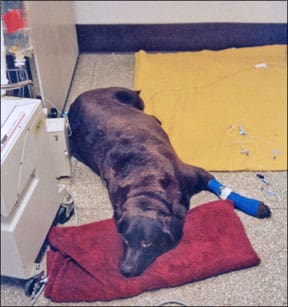
288
Why would a (Canadian) company located in the middle of the American wheat belt (Kansas) buy wheat products that have to be shipped half way around the world? It is not like we dont have enough wheat of our own; why are we buying wheat from China? And how many dogs and cats in China have been killed by that product? Come to think of it, how many people in China die from contaminated food? We will never know.
I have always made an effort to buy pet food made in the USA; it isnt difficult. However, it is difficult to buy treats that are made in the U.S. Nine out of ten treat products are made in Asia or South America. I avoid them on the theory that the lax manufacturing oversight in the U.S. is better than no oversight at all.
It appears that I am going to have to rethink my criteria for food, and buy food with all its ingredients grown and processed in the USA. I hereby challenge all companies claiming to make a top tier food to meet that challenge and say on the bag that the ingredients are 100 percent North American-sourced and -processed. I would be glad to vote with my pet food dollars.
Mike Burks
via e-mail
Weve learned that wheat gluten from China costs about 10 cents less per pound than U.S.-grown and -processed wheat gluten, which costs around 60 cents per pound. Multiply that by the 792 metric tons of wheat gluten imported in the same lot as the contaminated product bought by Menu, and you begin to understand the size of the problem. I dont know how much of this wheat gluten Menu bought, but I do know that its very difficult for companies to take a pass on savings of that magnitude.
Of course, weve also now seen what the hidden price of a bargain ingredient may be.
Using U.S.-grown and -processed sources of ingredients that are abundant here makes sense.
I just read Mary Straus first article on feeding home-prepared diets to dogs. Although she is preaching to the converted with regard to me, I am still delighted to know that we will be getting the benefit of her excellent research and expertise. I have great respect for Mary, having read many of her articles in various media, and Im eagerly looking forward to the rest of the series.
I am getting a new GSD puppy in three weeks and having never fed a pup a home-prepared diet (although my last dog was fed a raw diet for eight years). Im relieved that I will have Mary to advise me on the best way to proceed.
Whole Dog Journal is the best thing to ever happen to those of us who care about the health and mental well-being of our dogs. (Ive also purchased Pat Millers book on positive dog training. Her training articles are excellent.)
Carol Marsh
Kanata, Ontario
Why cant Whole Dog Journal list all of its top foods on its website for all dog owners to benefit from? I contacted your customer service department and was told I would have to pay for a subscription or a back issue if I wanted that information. Im looking for safe foods. Clearly you care more about profits than saving the lives of dogs. I will never subscribe and support a company that puts its profits before anyone else. Besides, I found the information on a website for free.
Wow.
First, because we do not sell advertising, we must charge for our content. If we gave it away, we wouldnt be able to pay our contributors, printer, etc., and we wouldnt be able to continue to research and analyze the pet food industry (and other canine-health-related industries).
Yes, our publisher is a for-profit company, and we expect to be paid for expert analysis. We dont think that makes us puppy killers. You must value what we have to say, or you wouldnt be driven to search for a free way to access it! We would think your peace of mind would be worth the price of a subscription.




